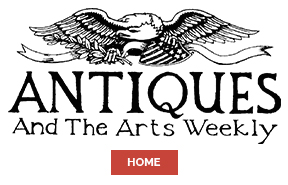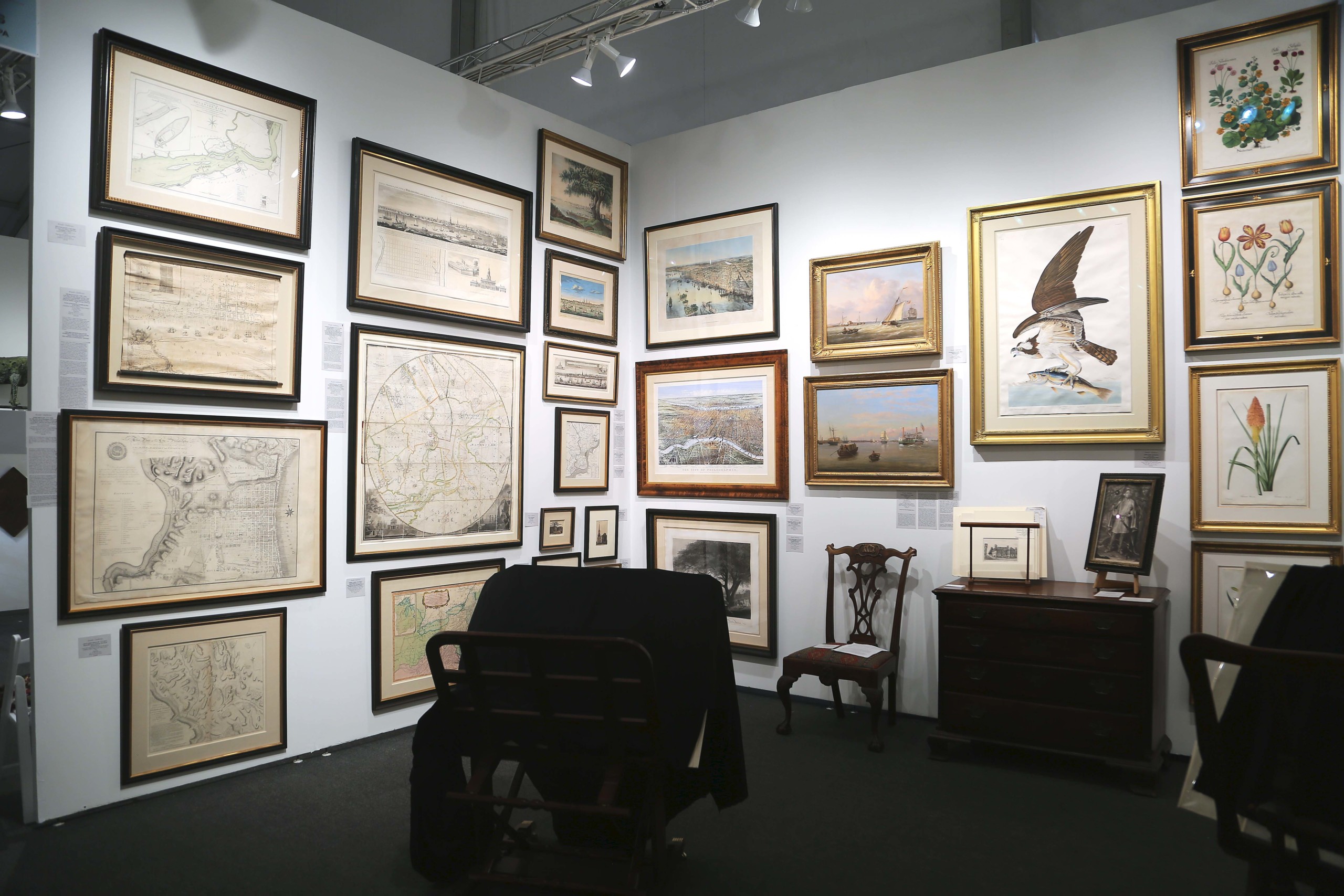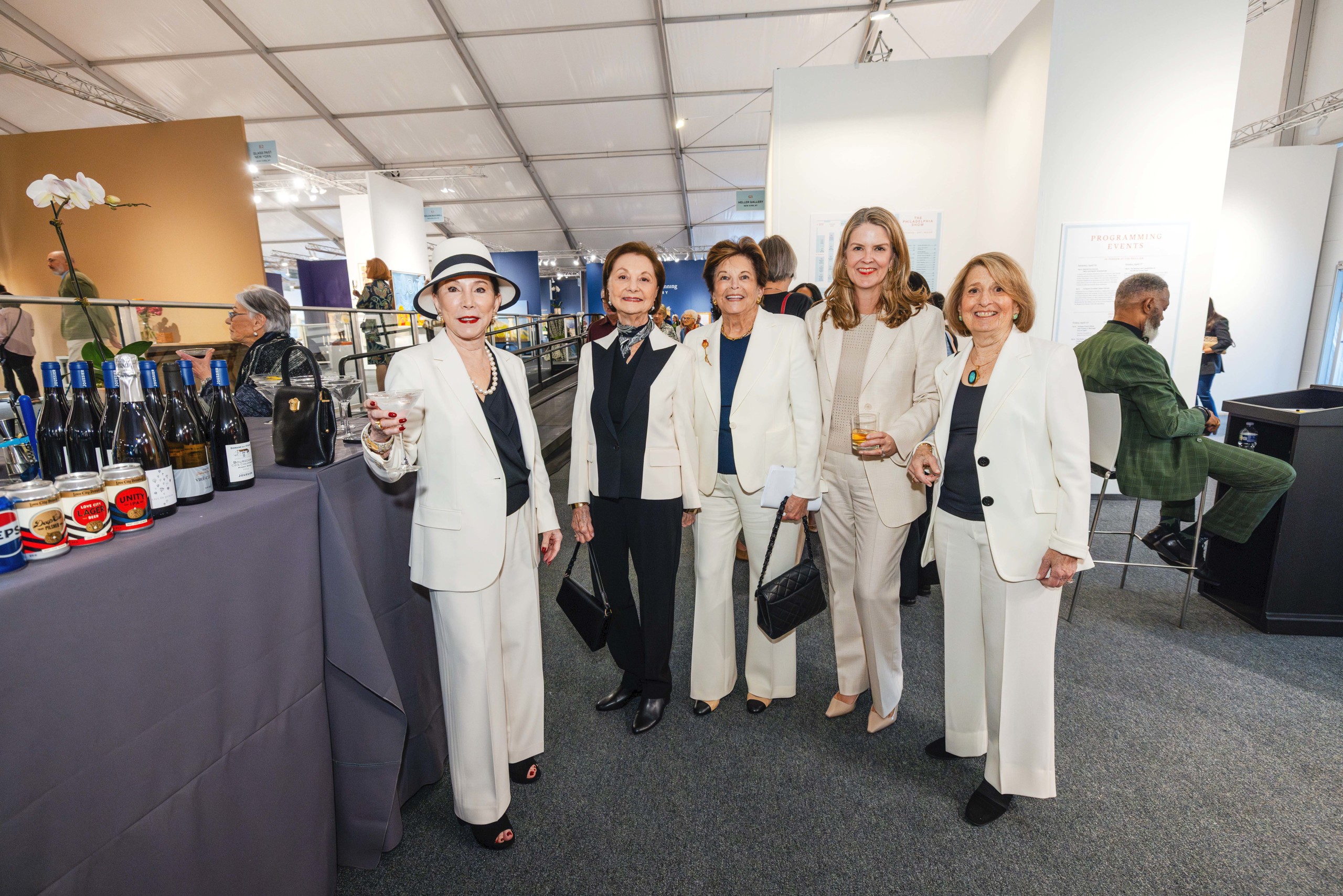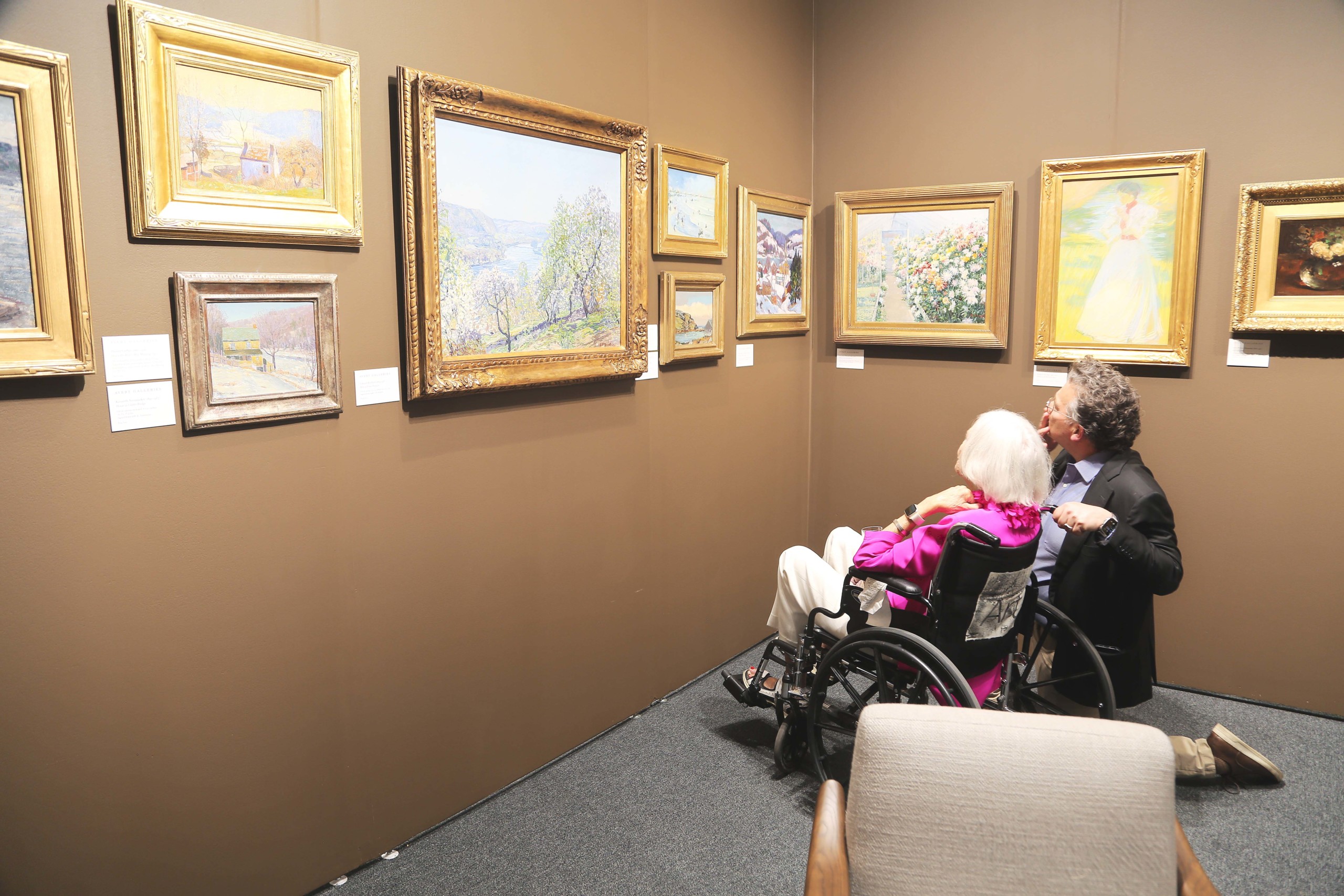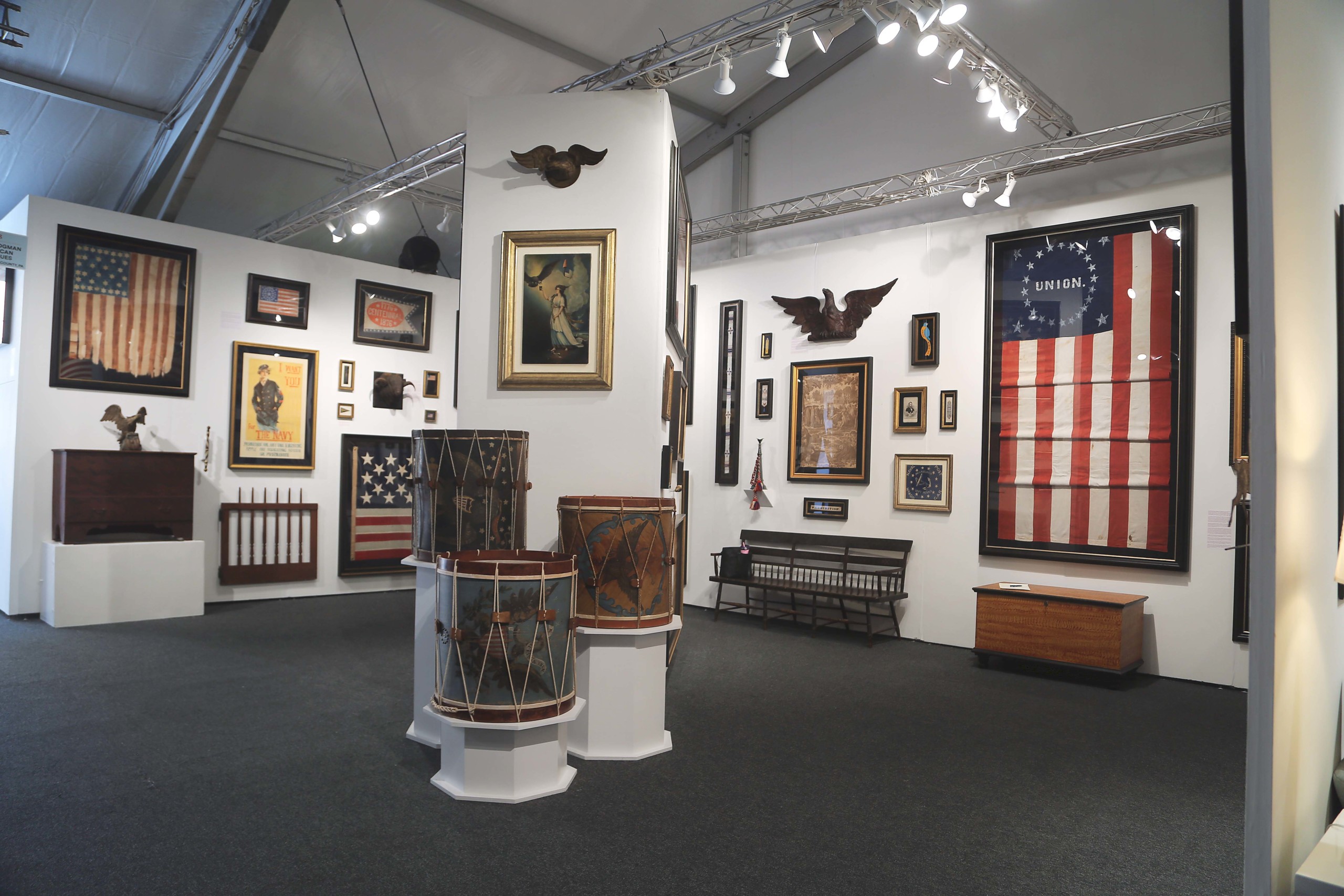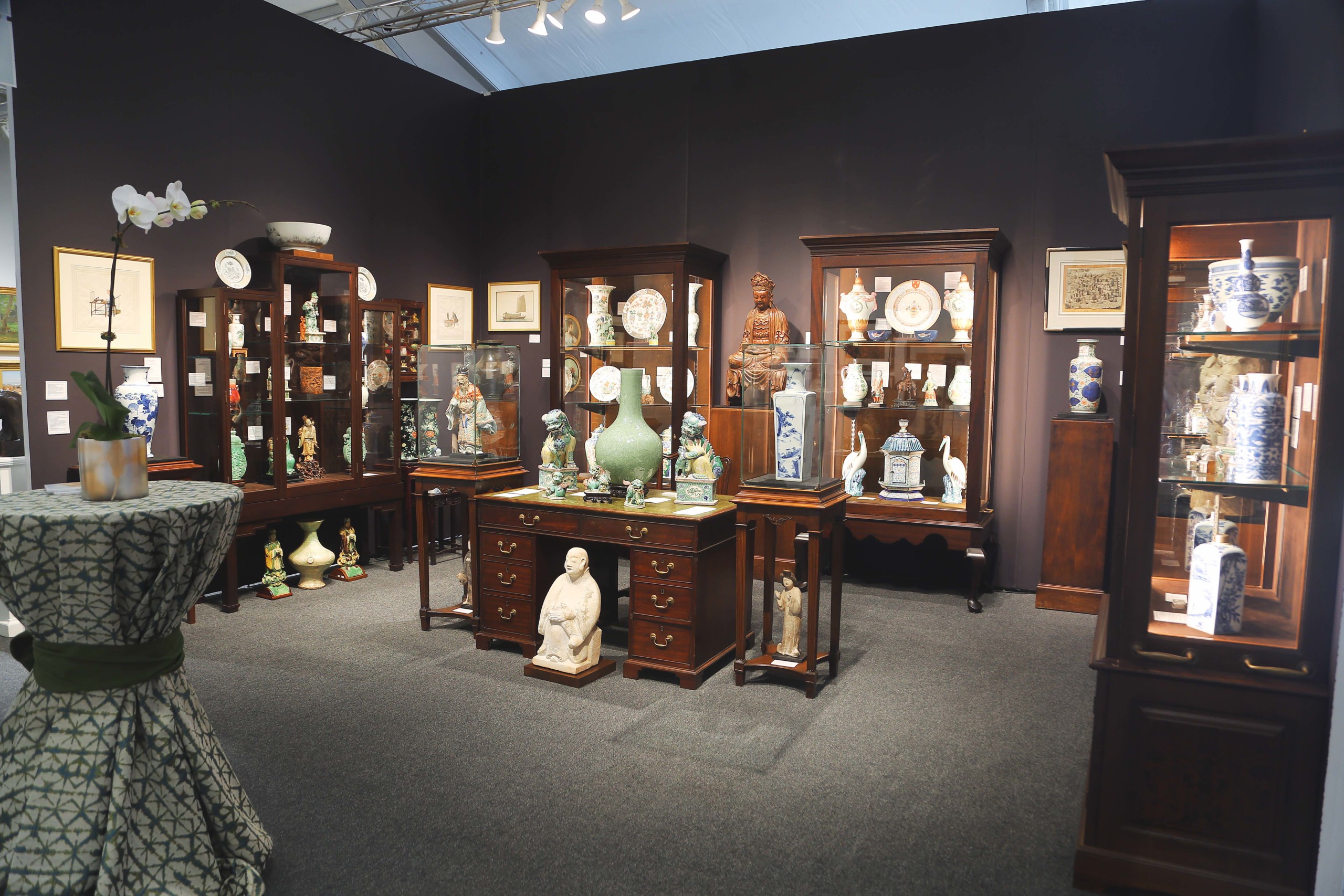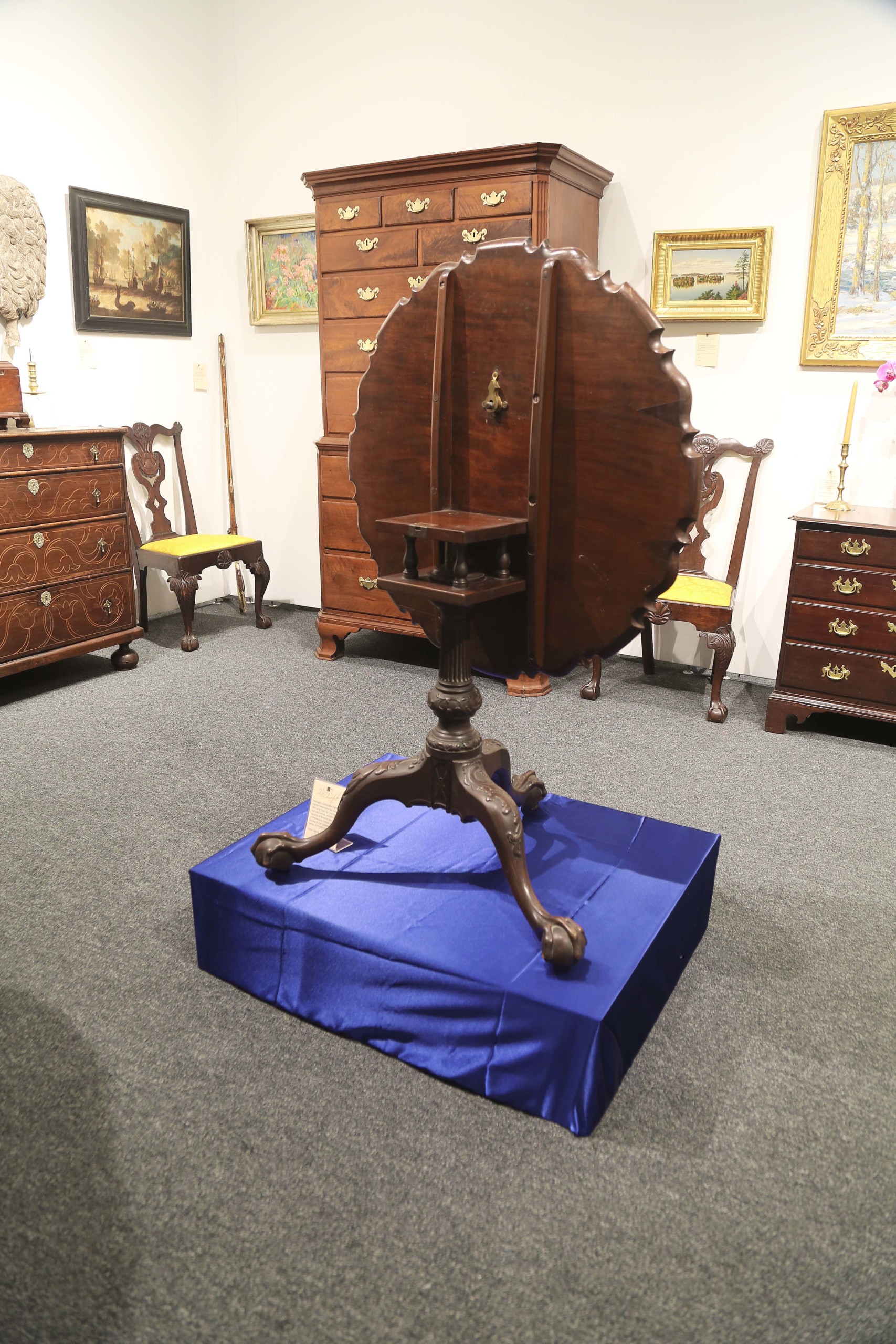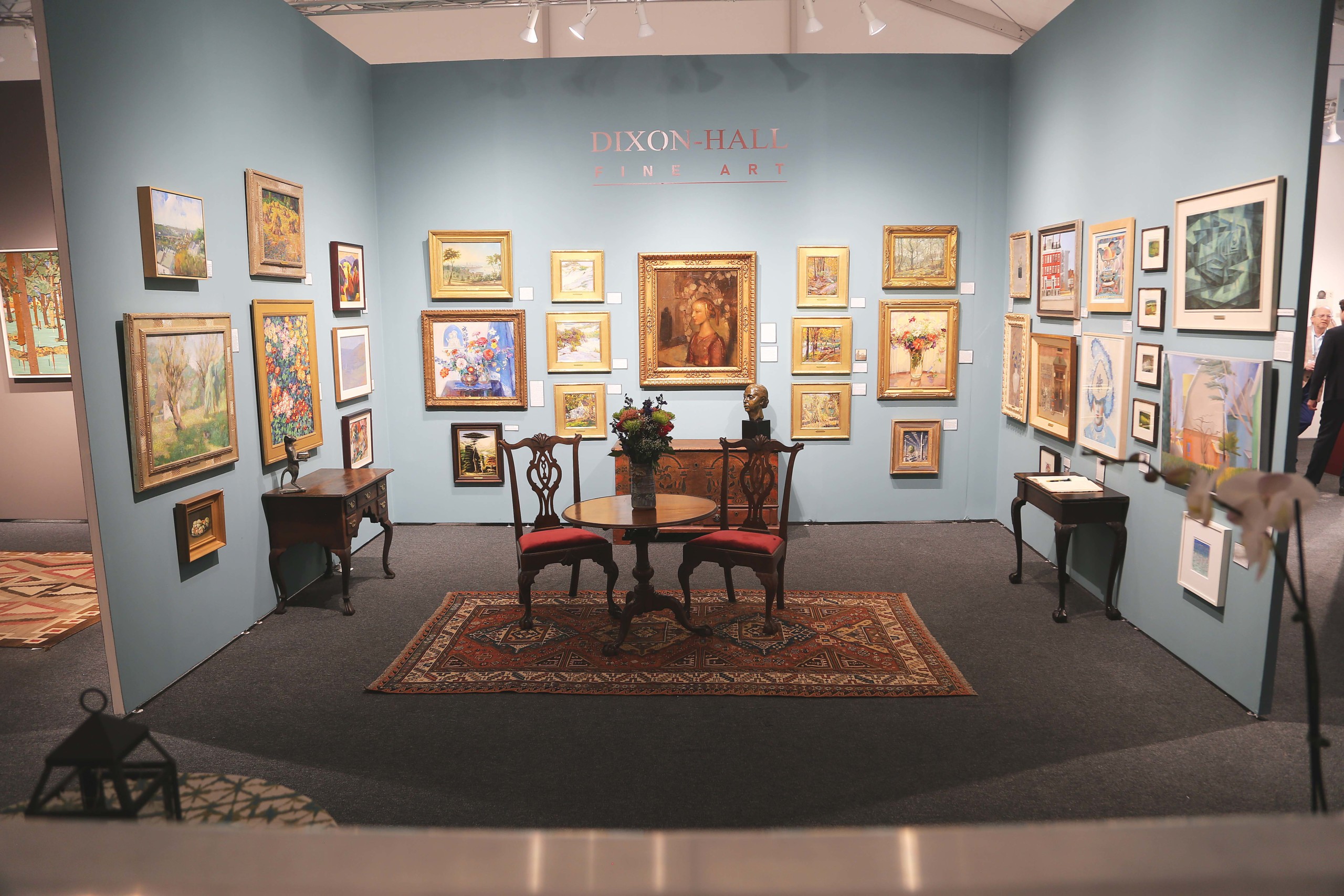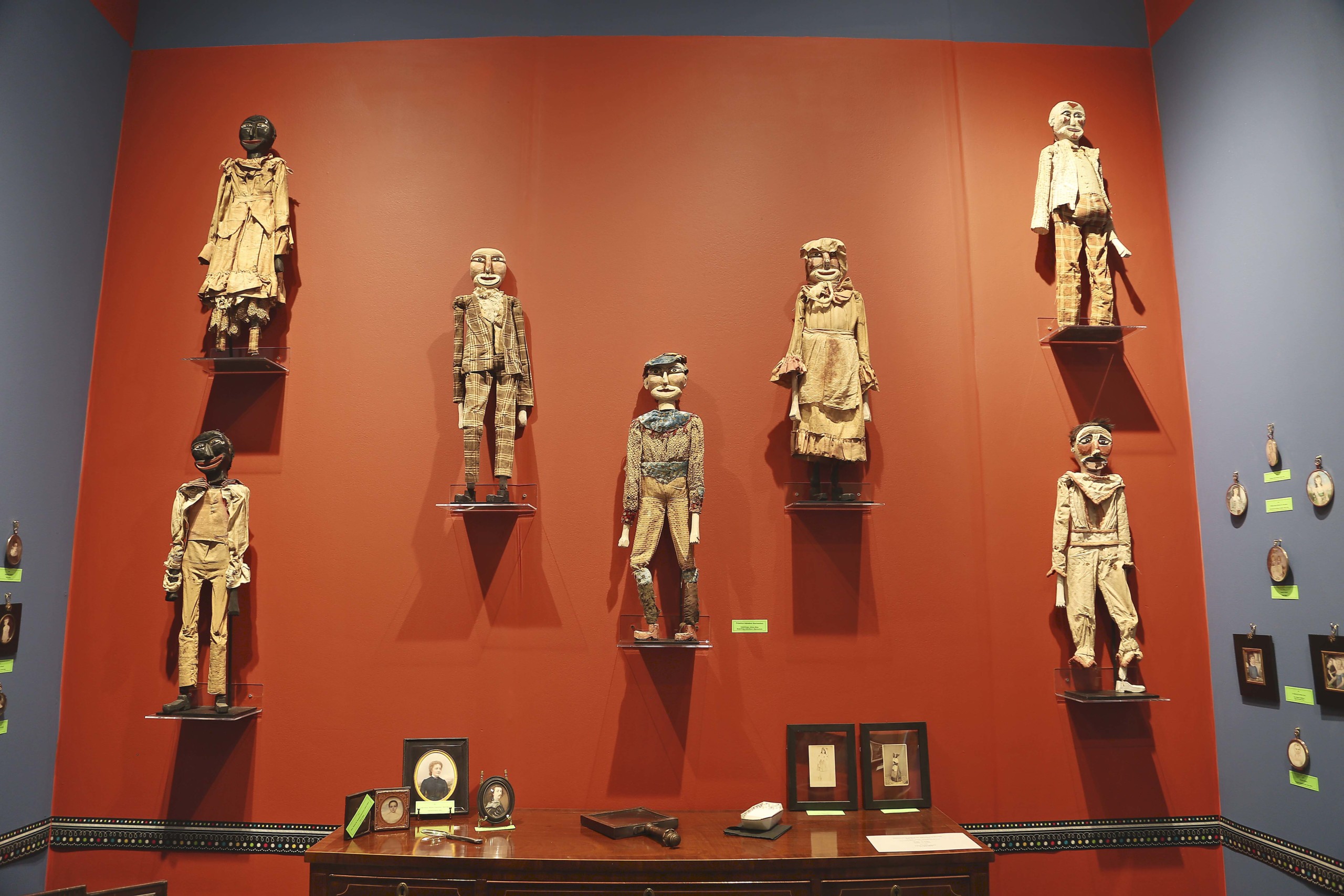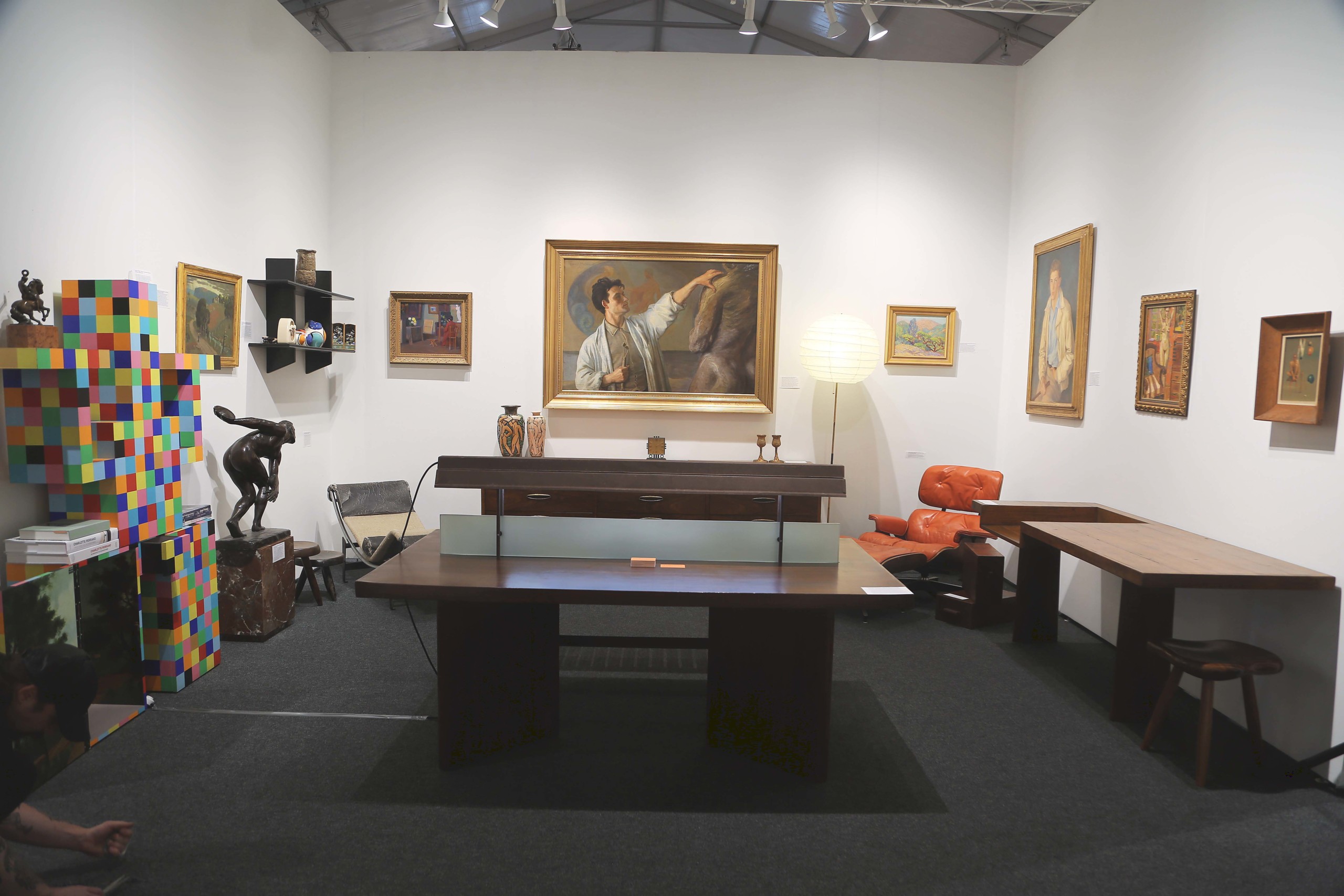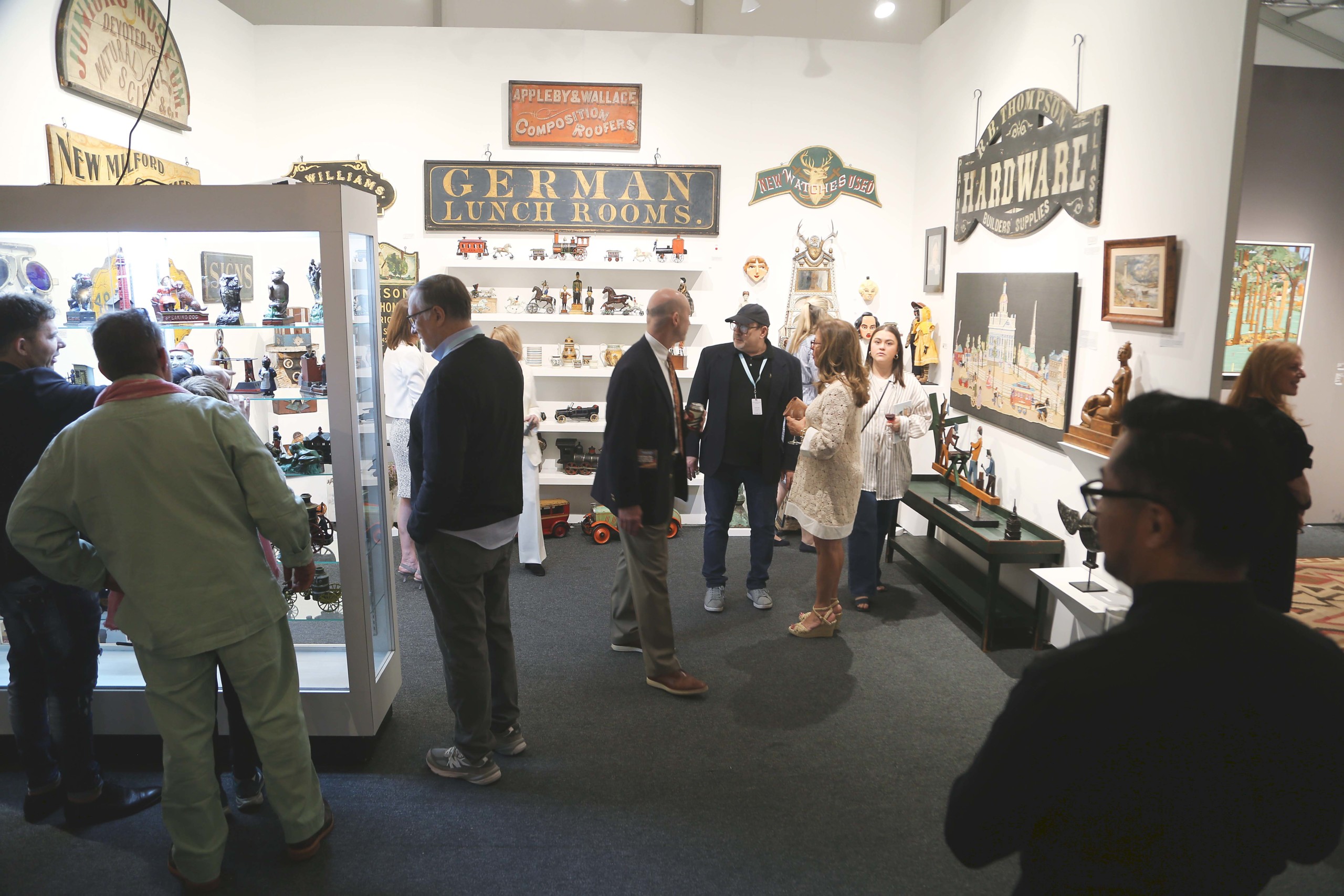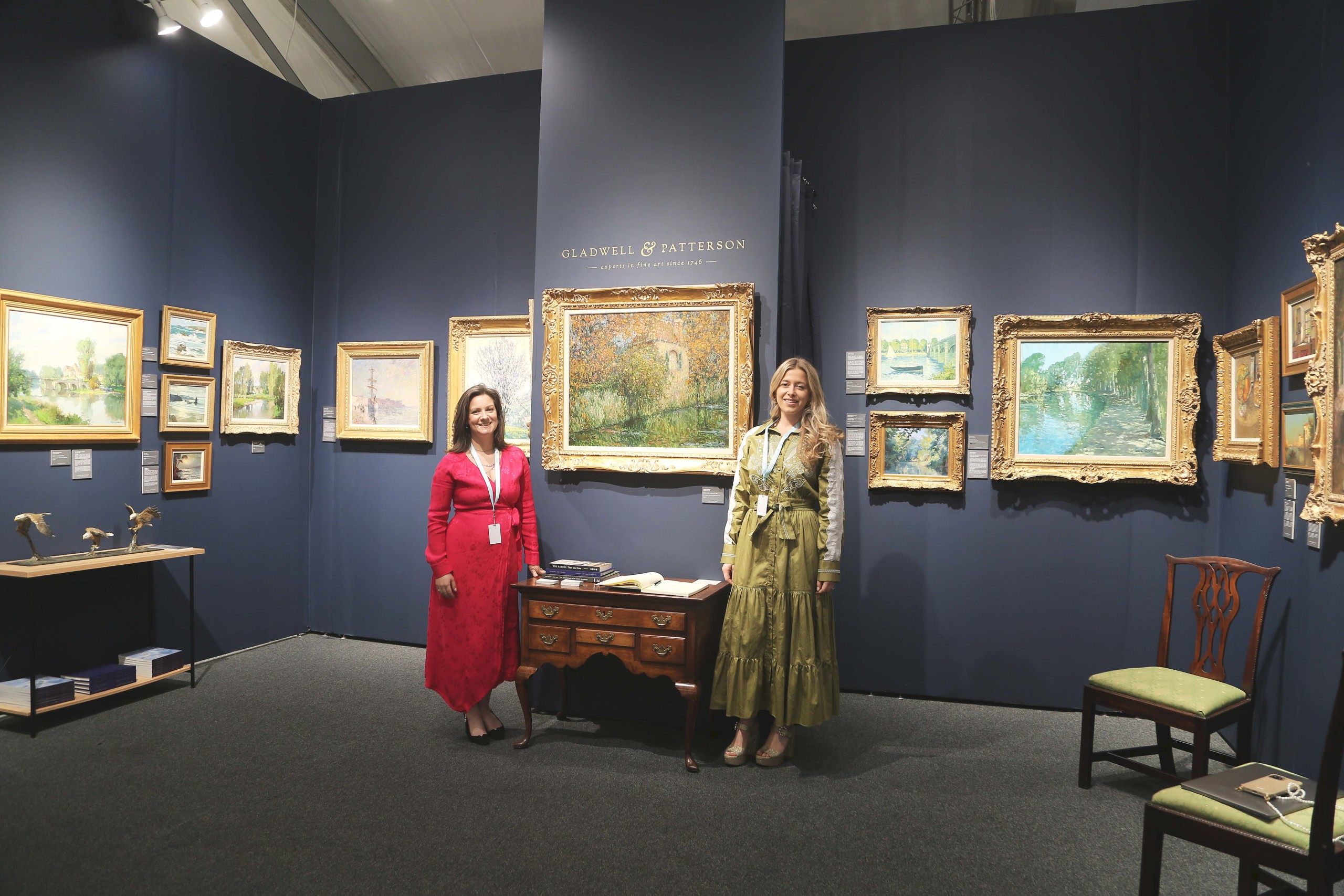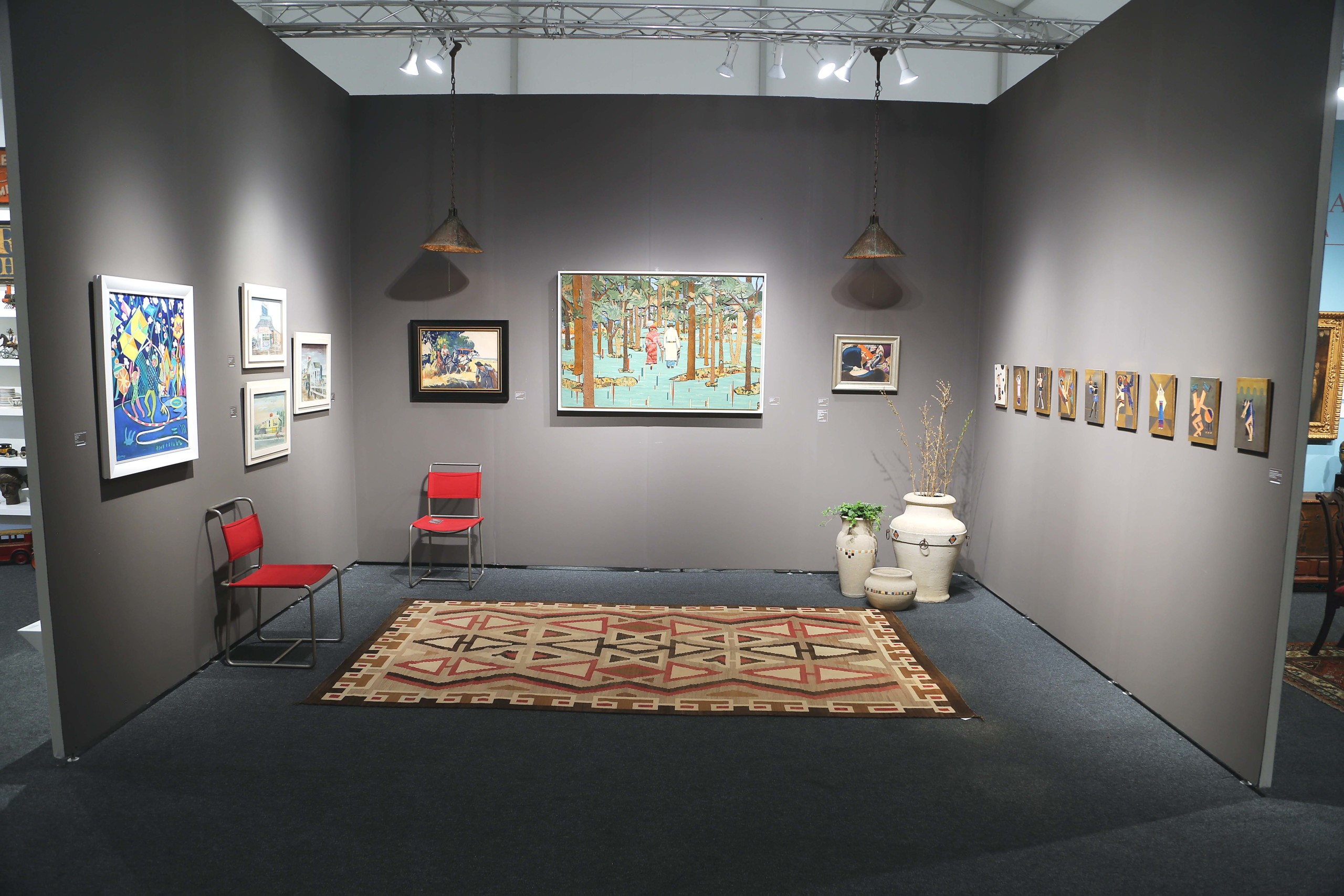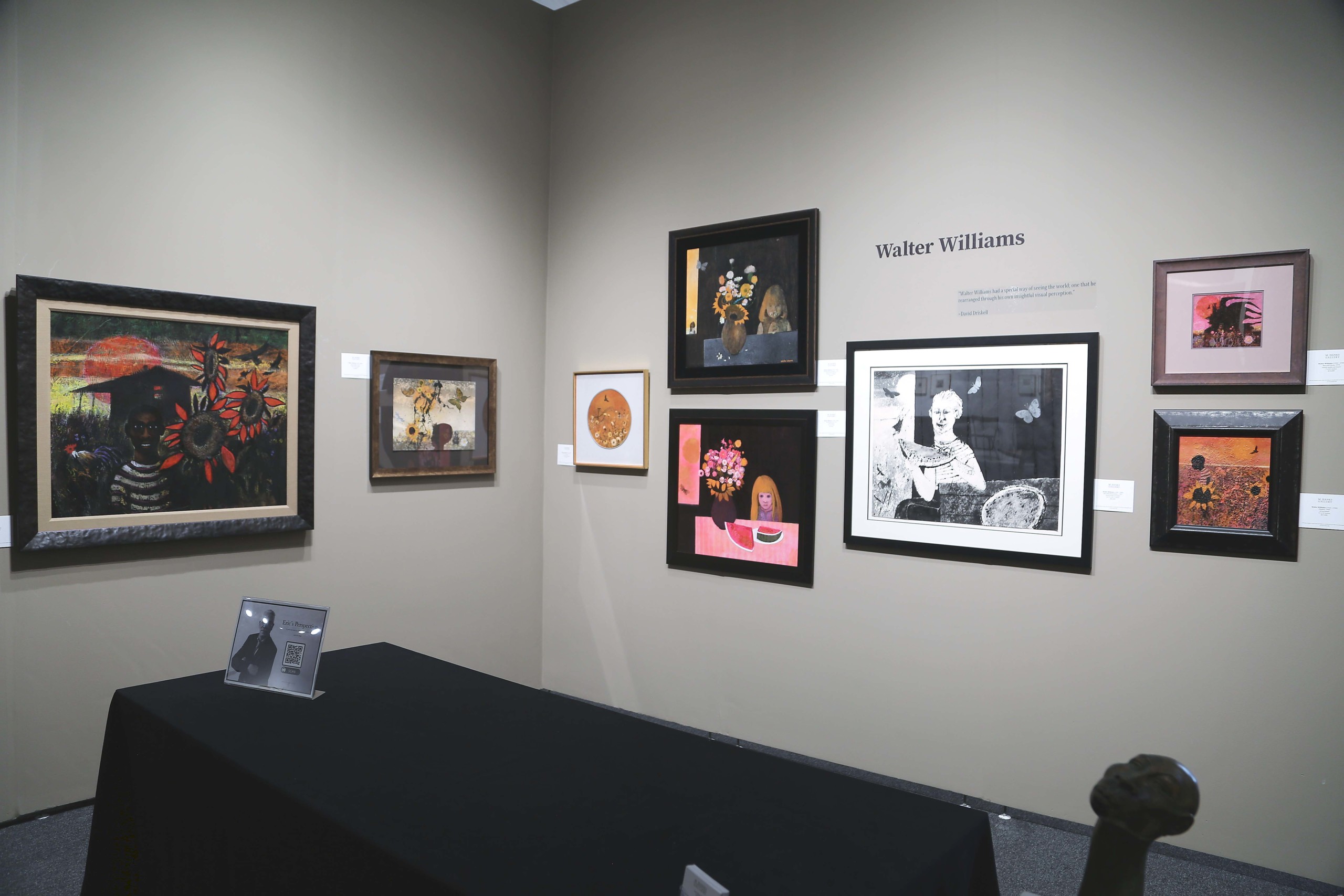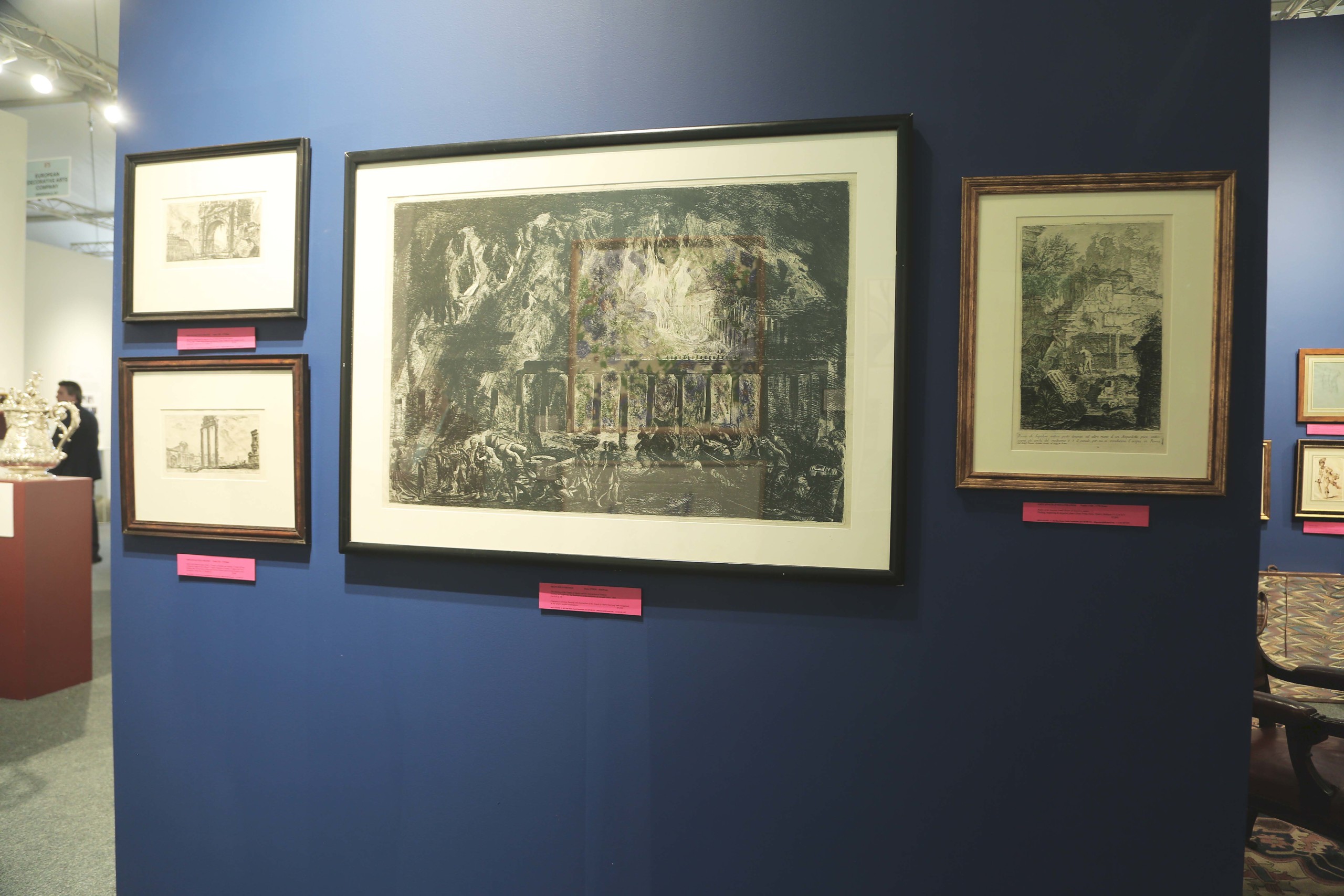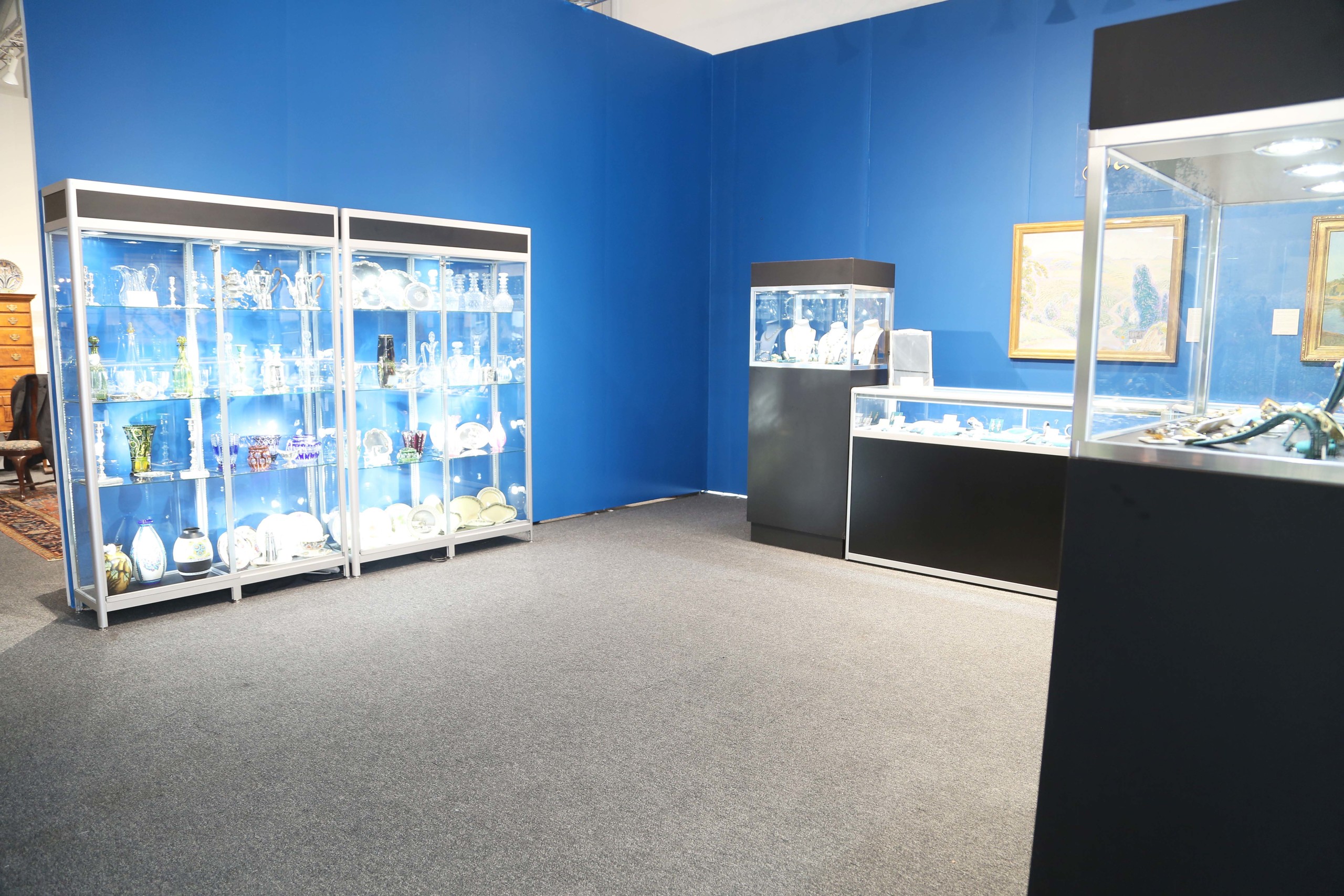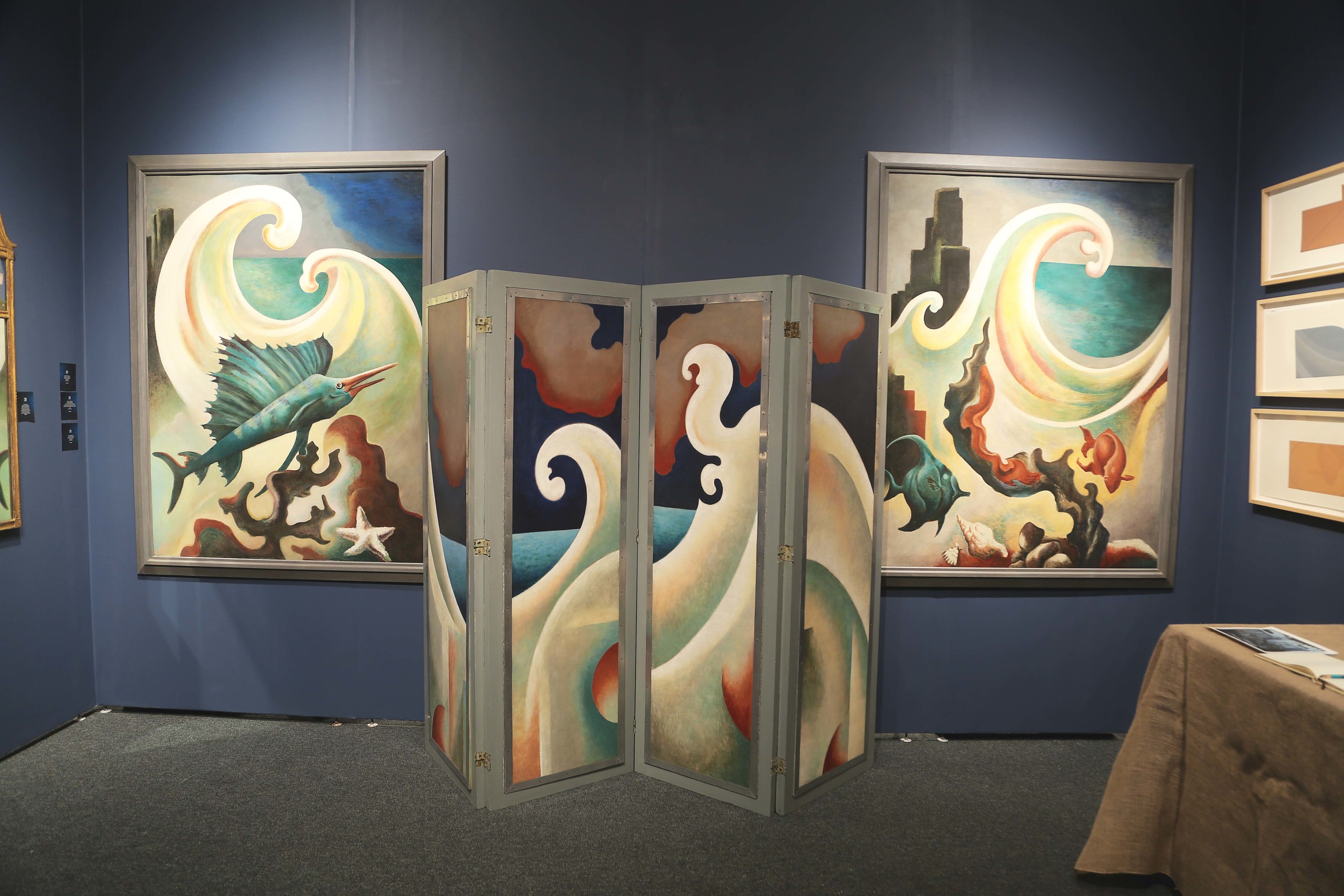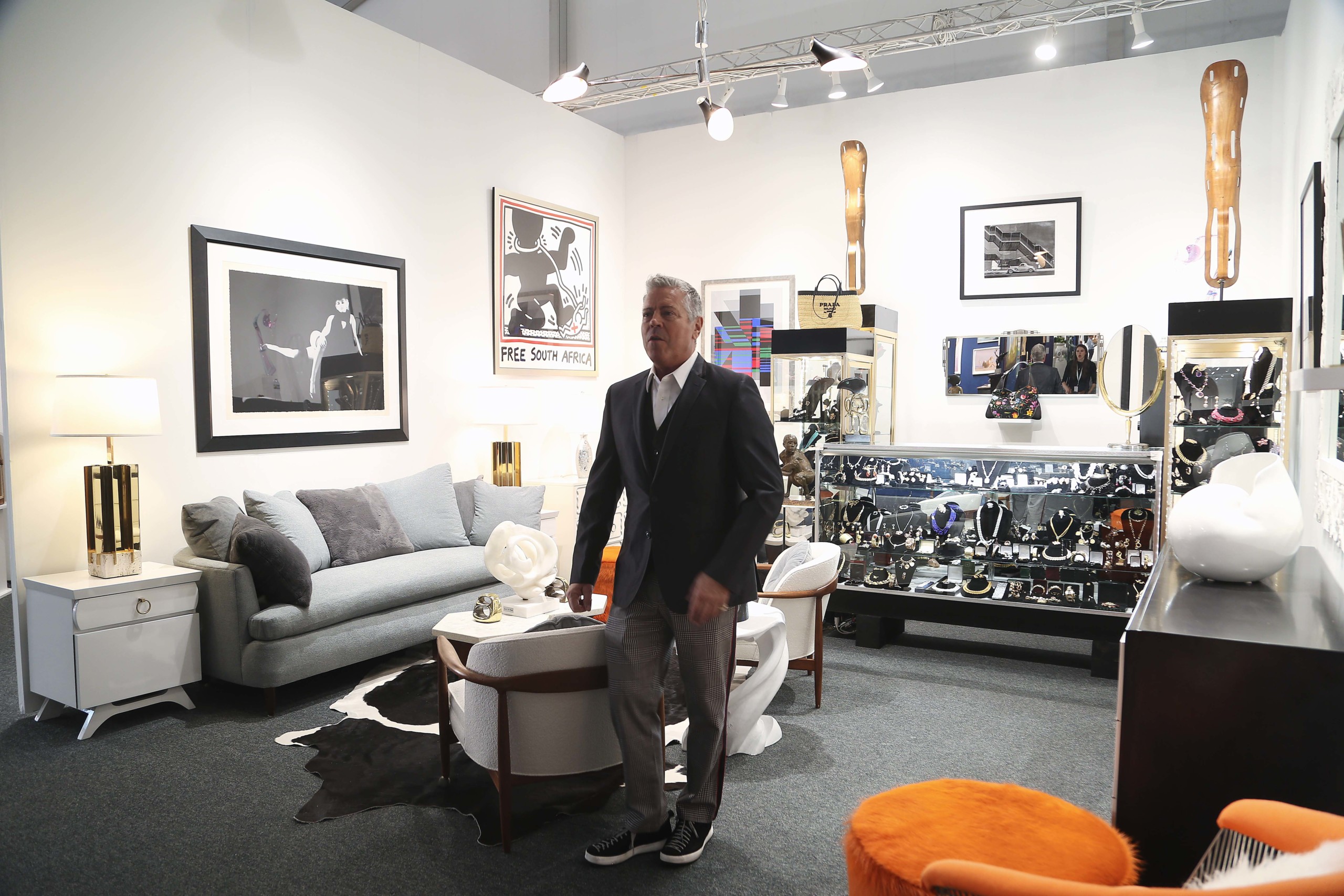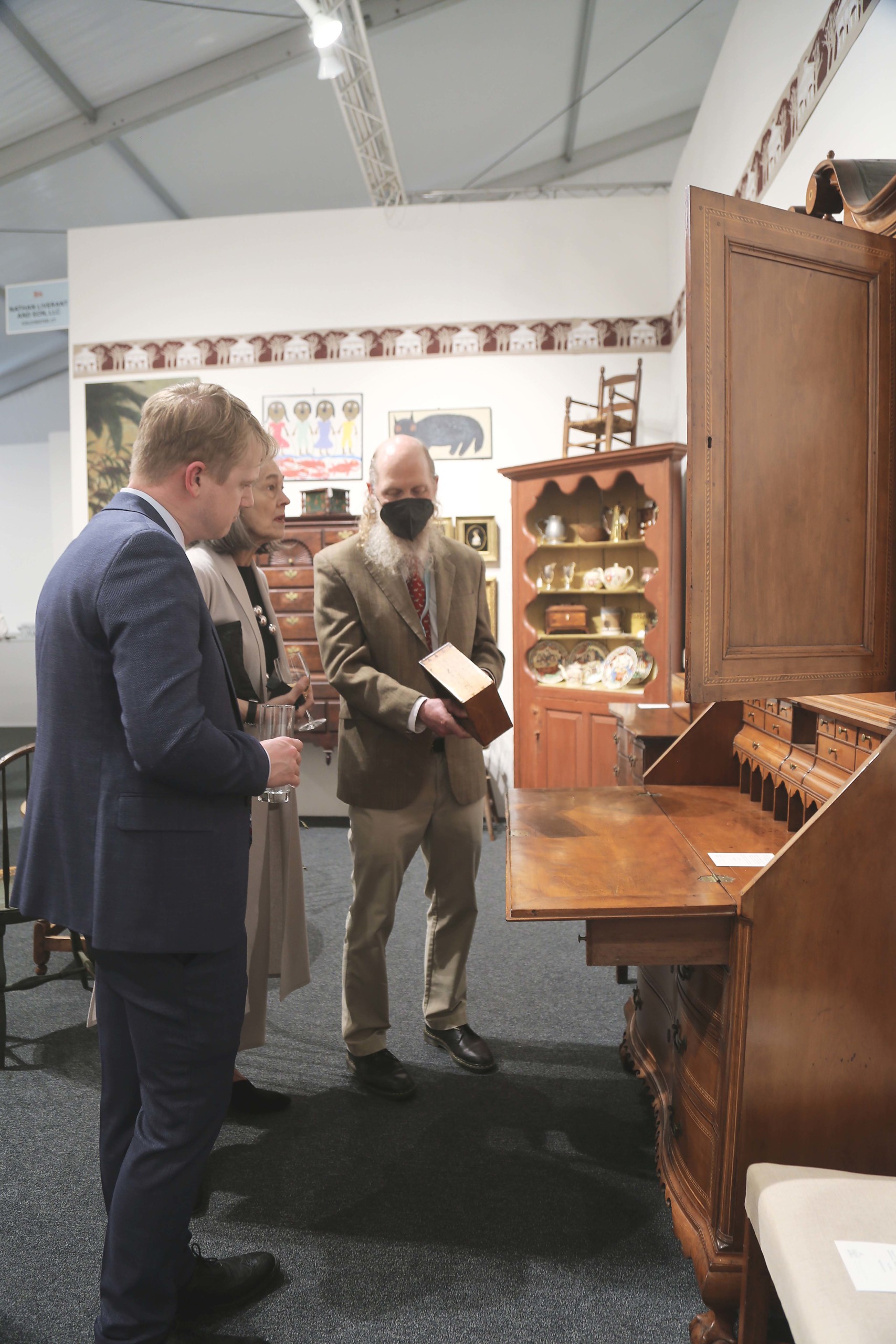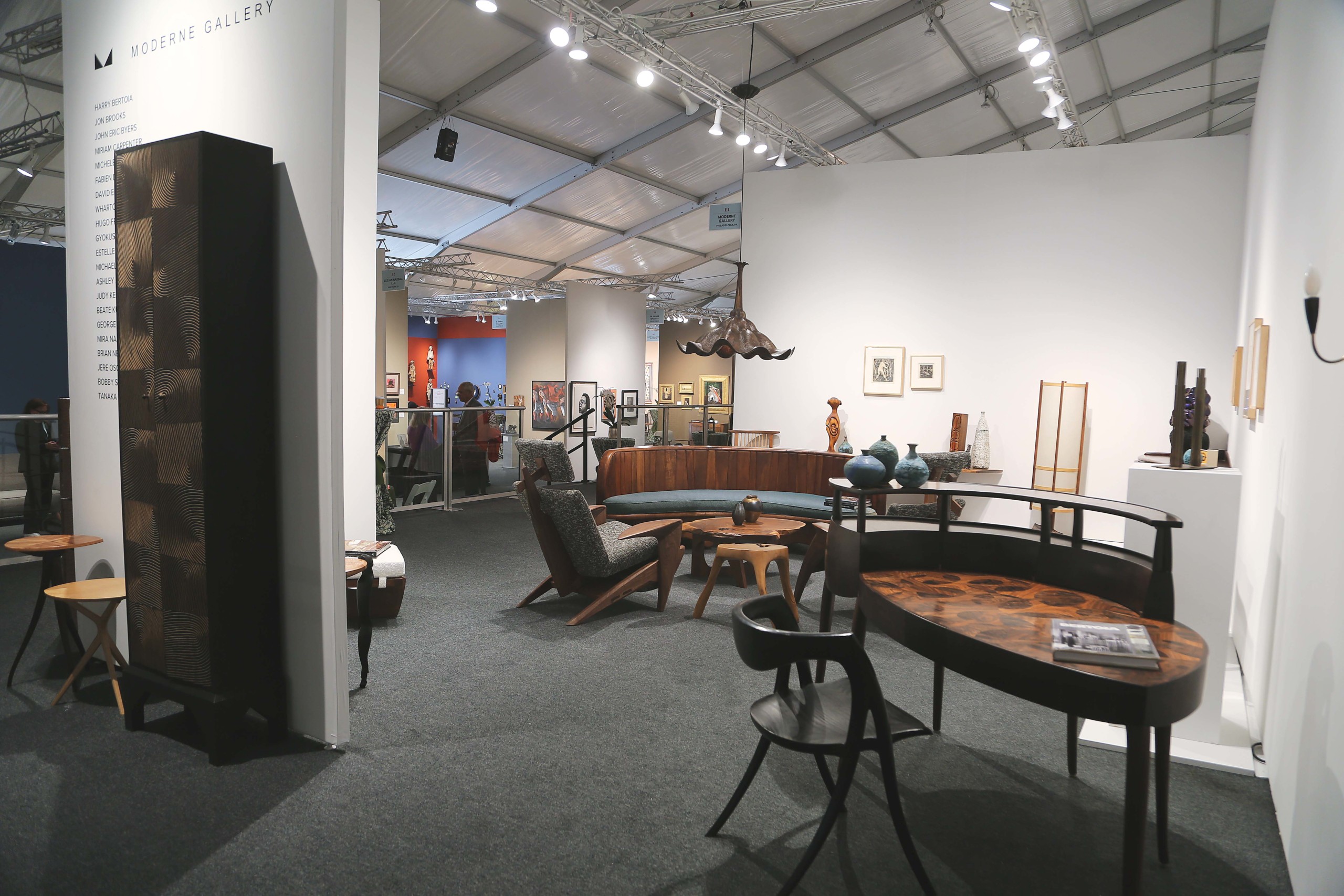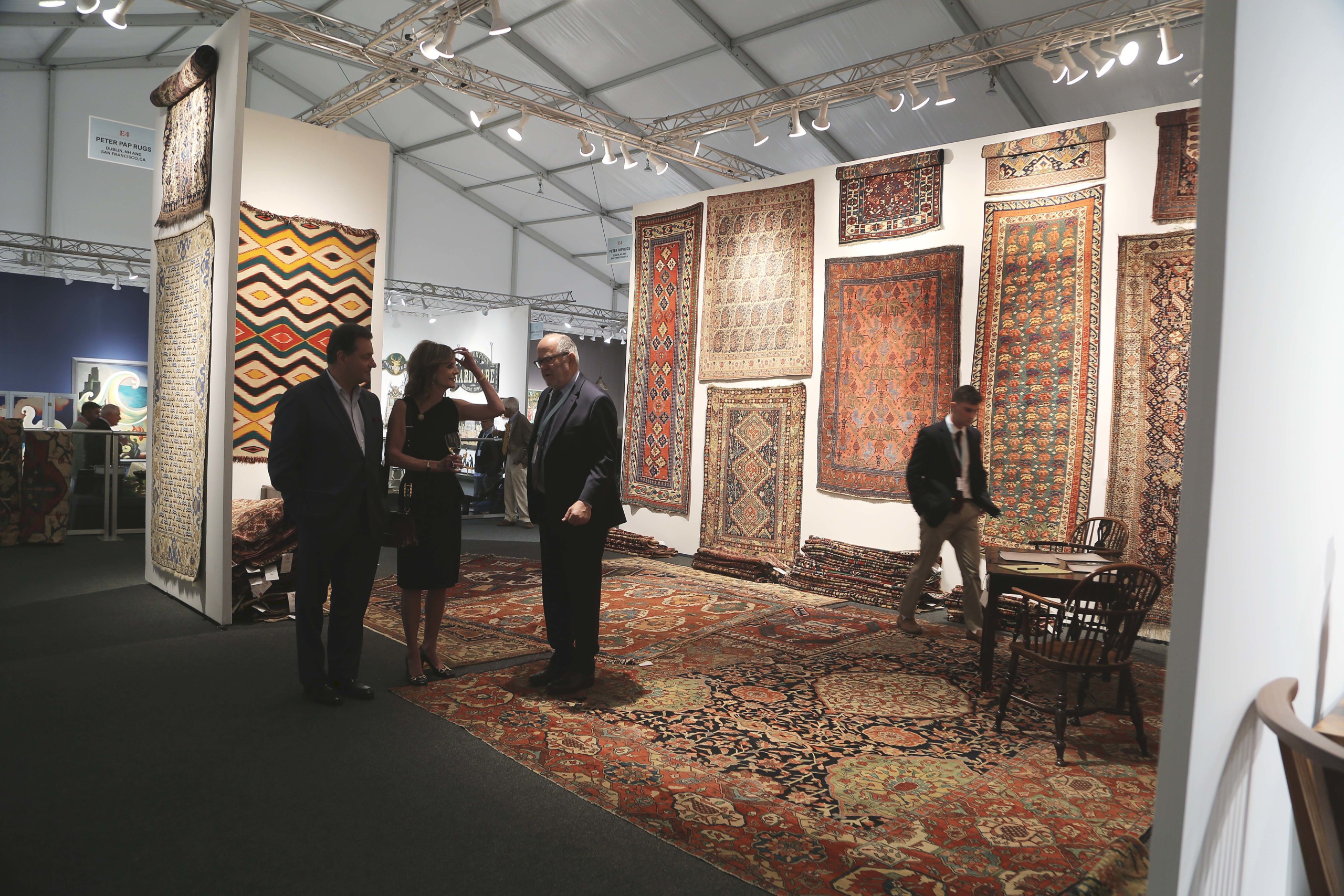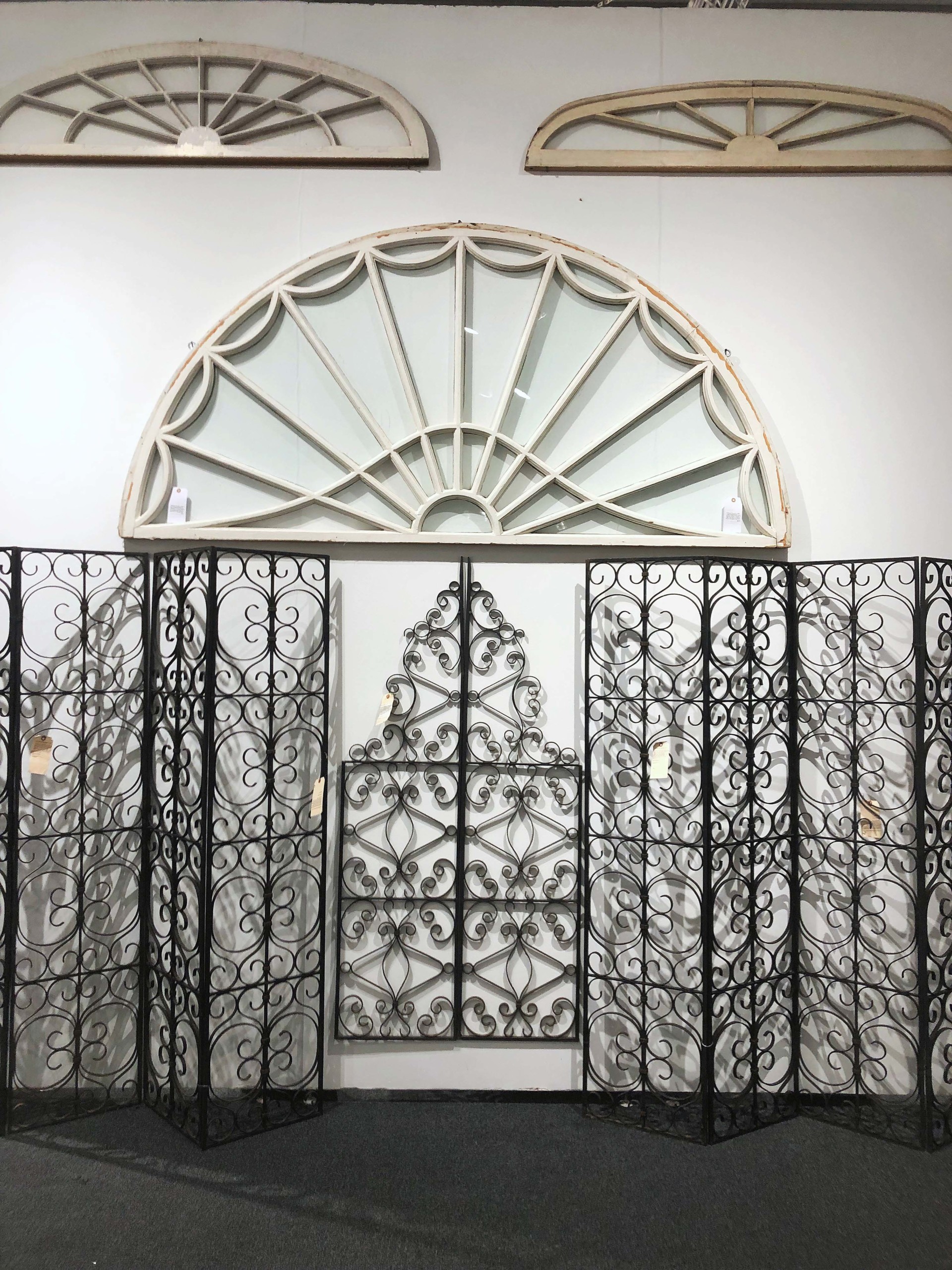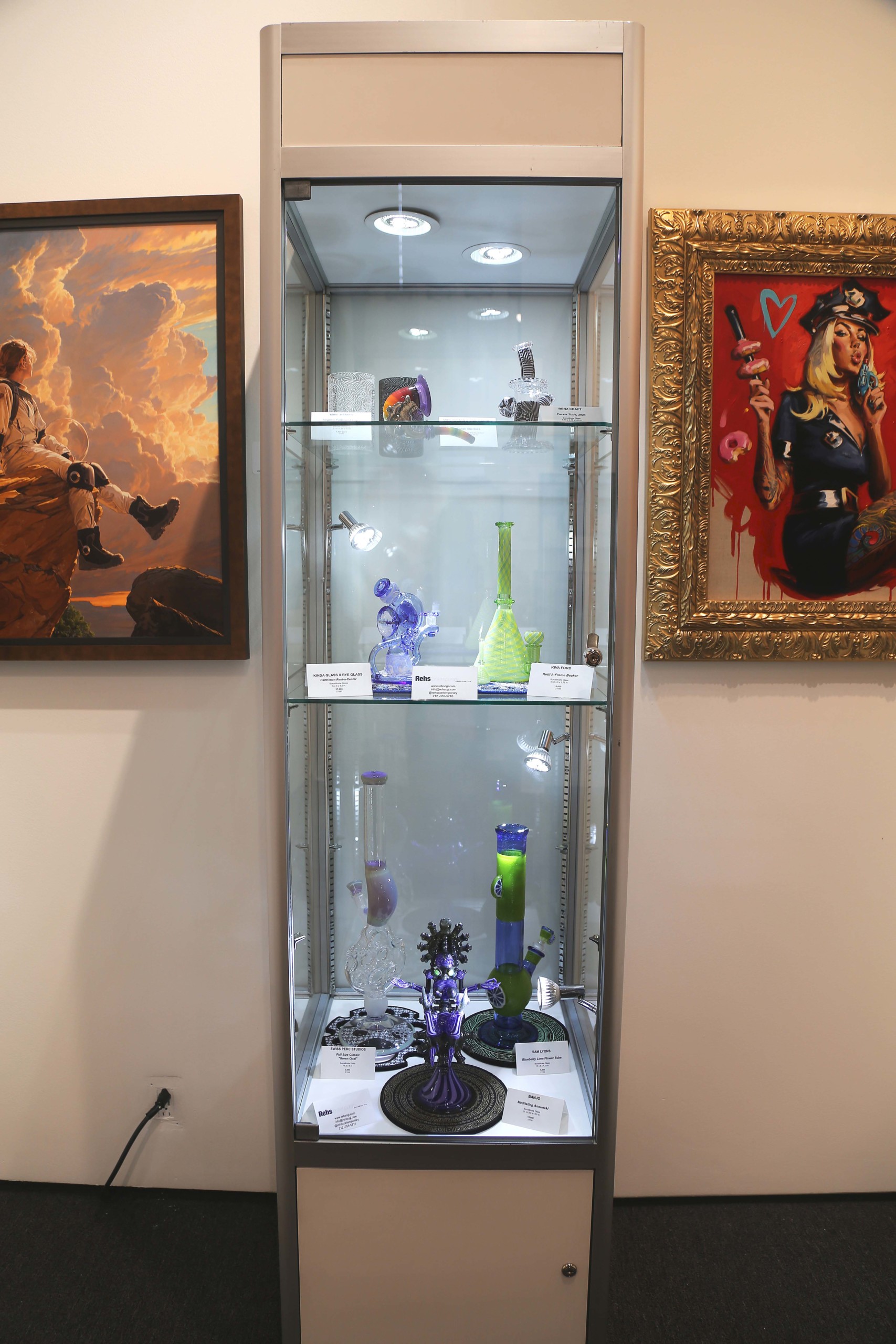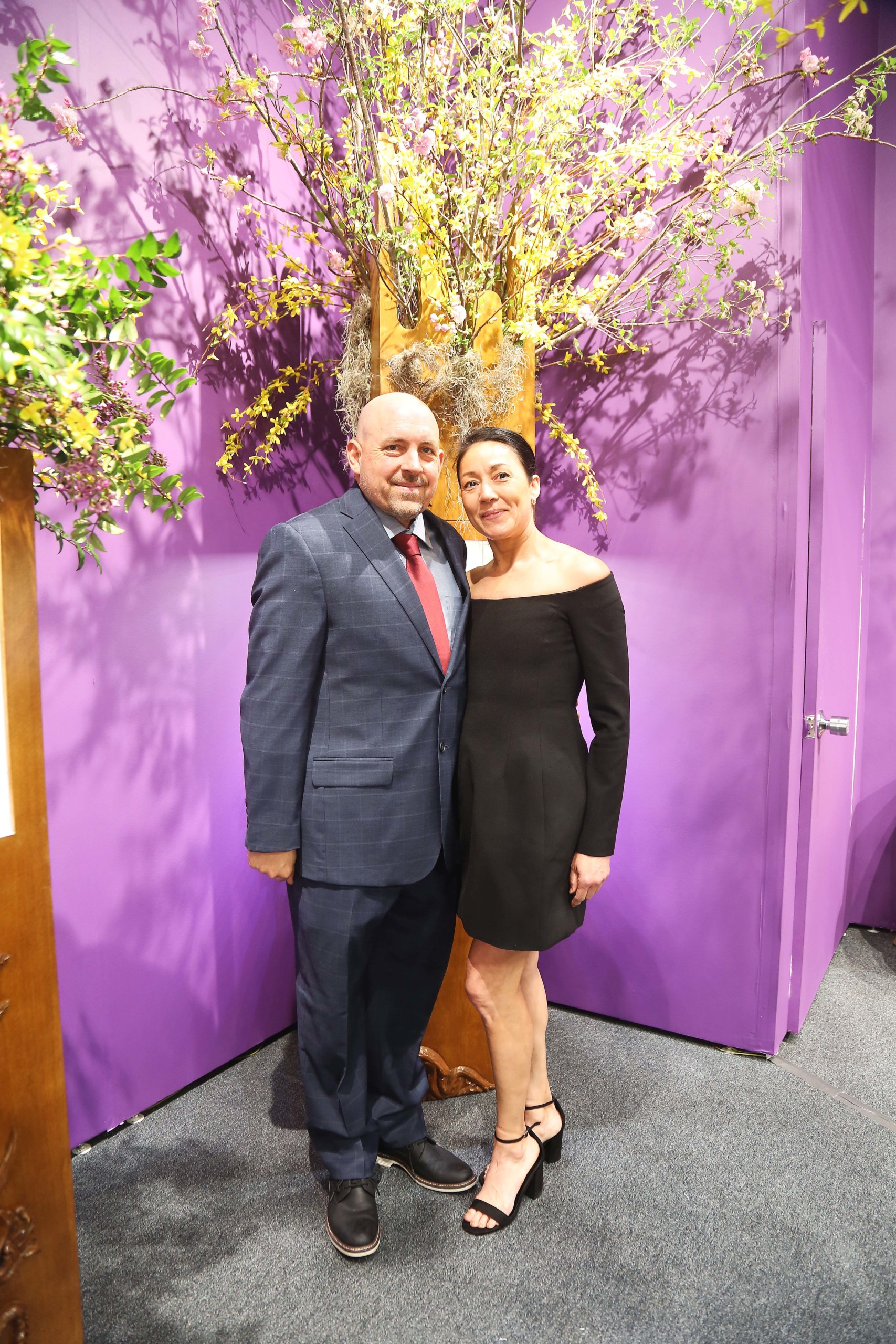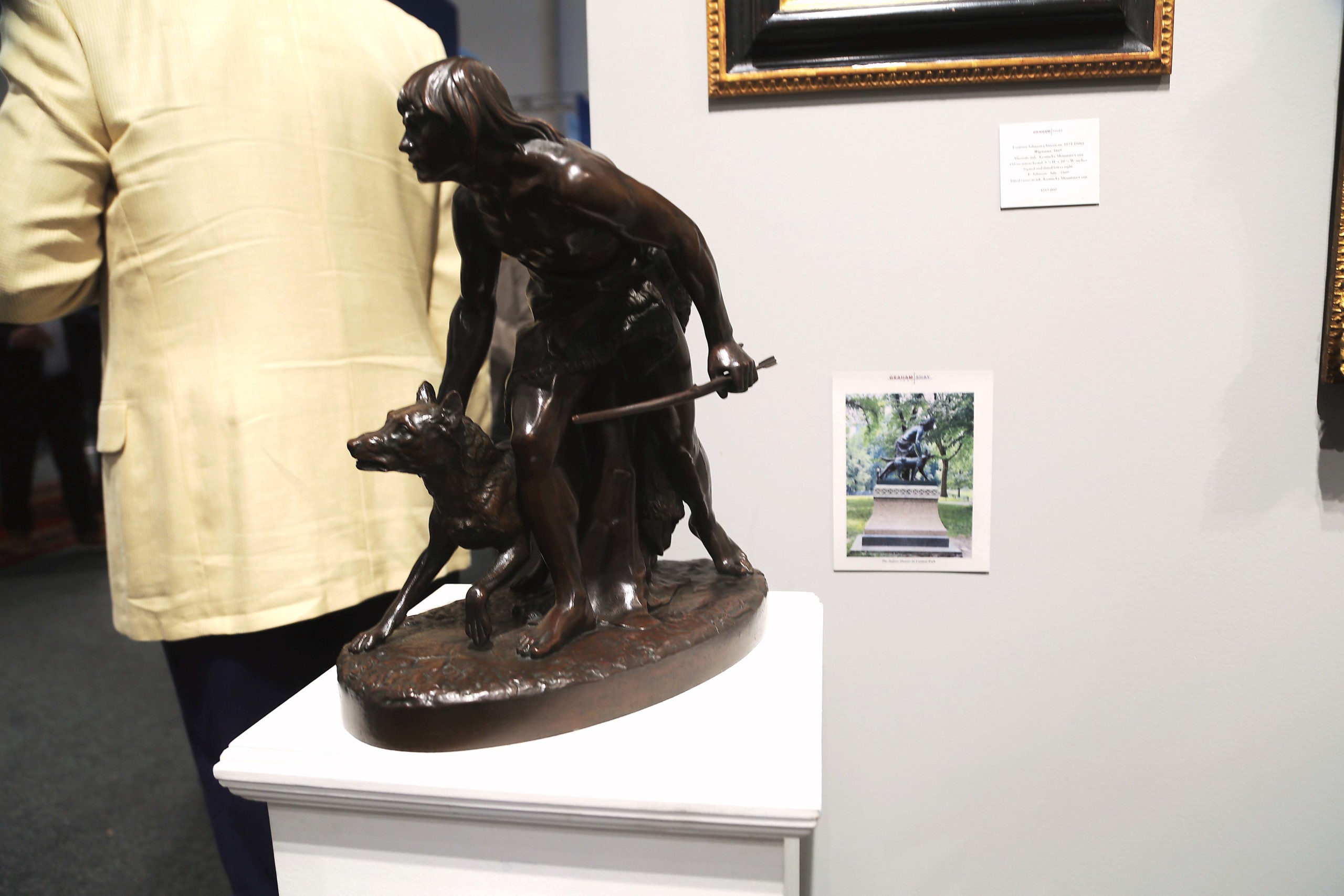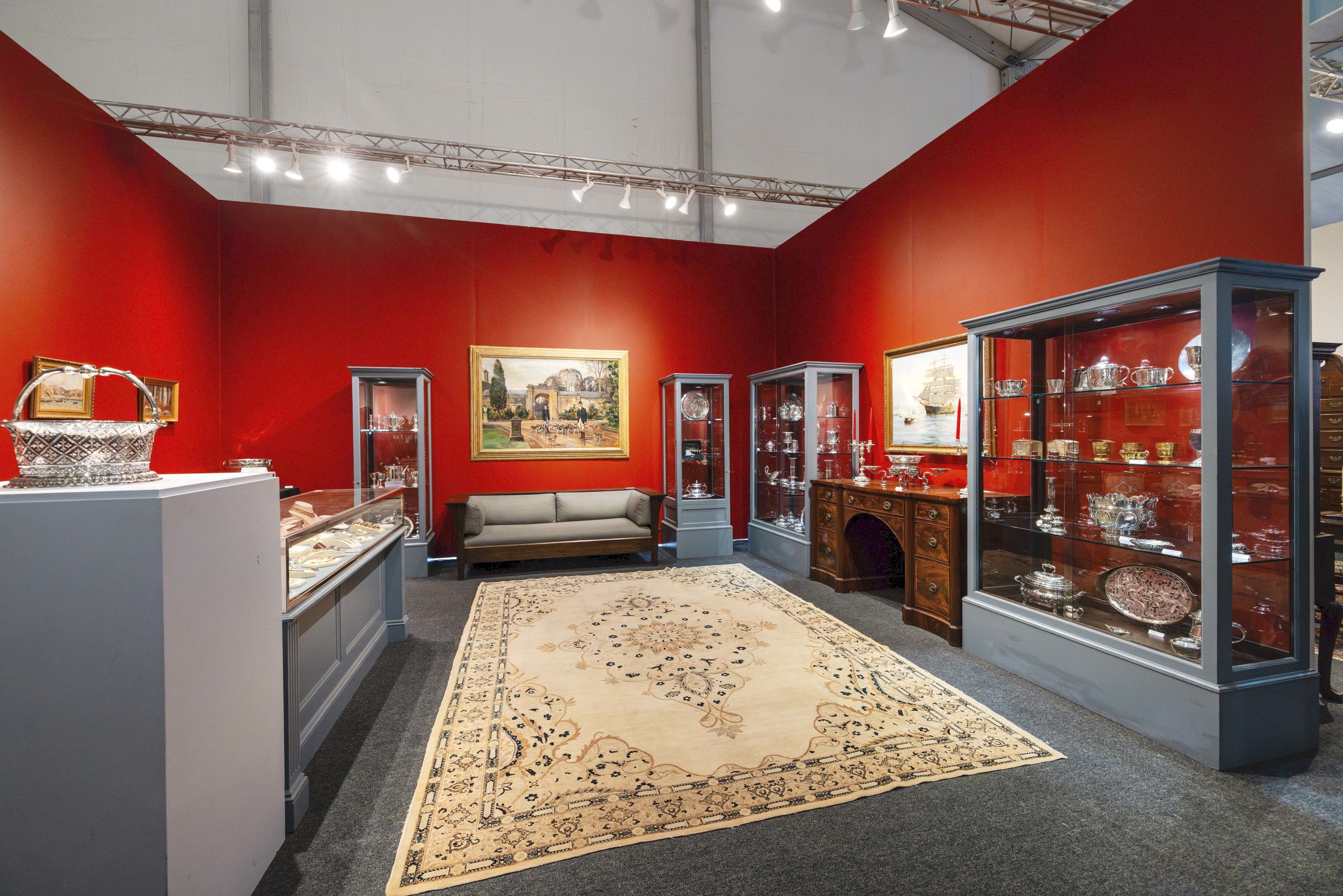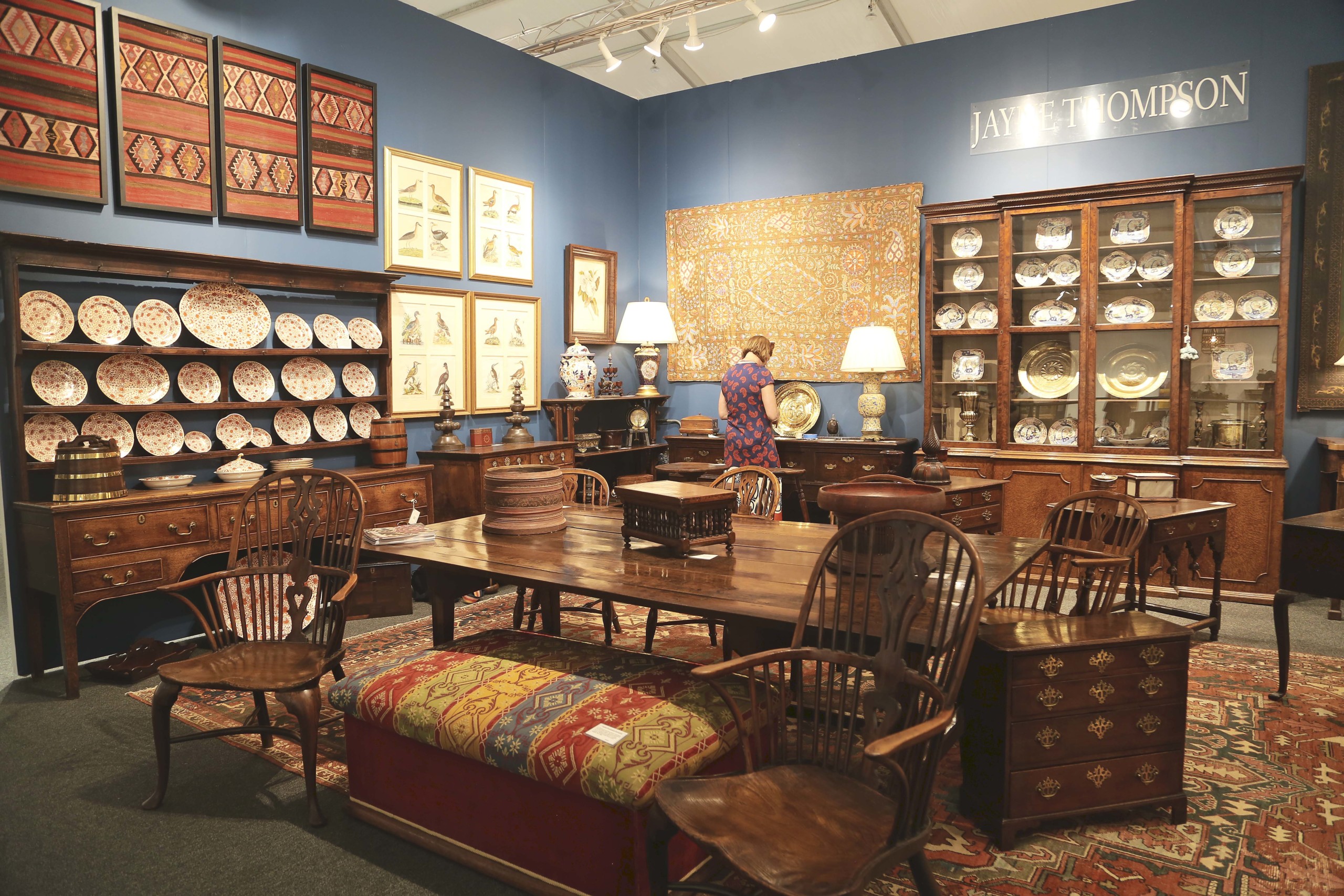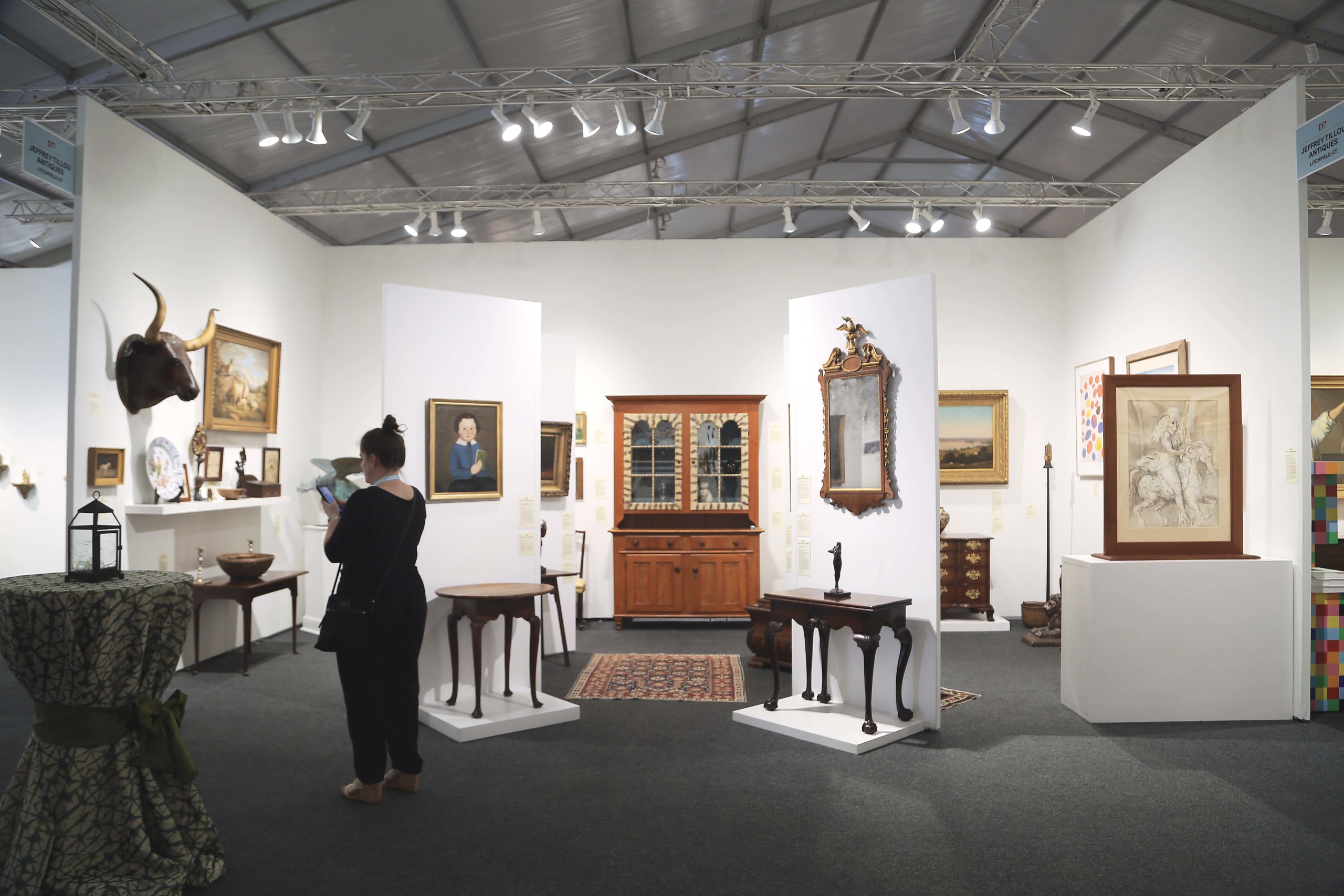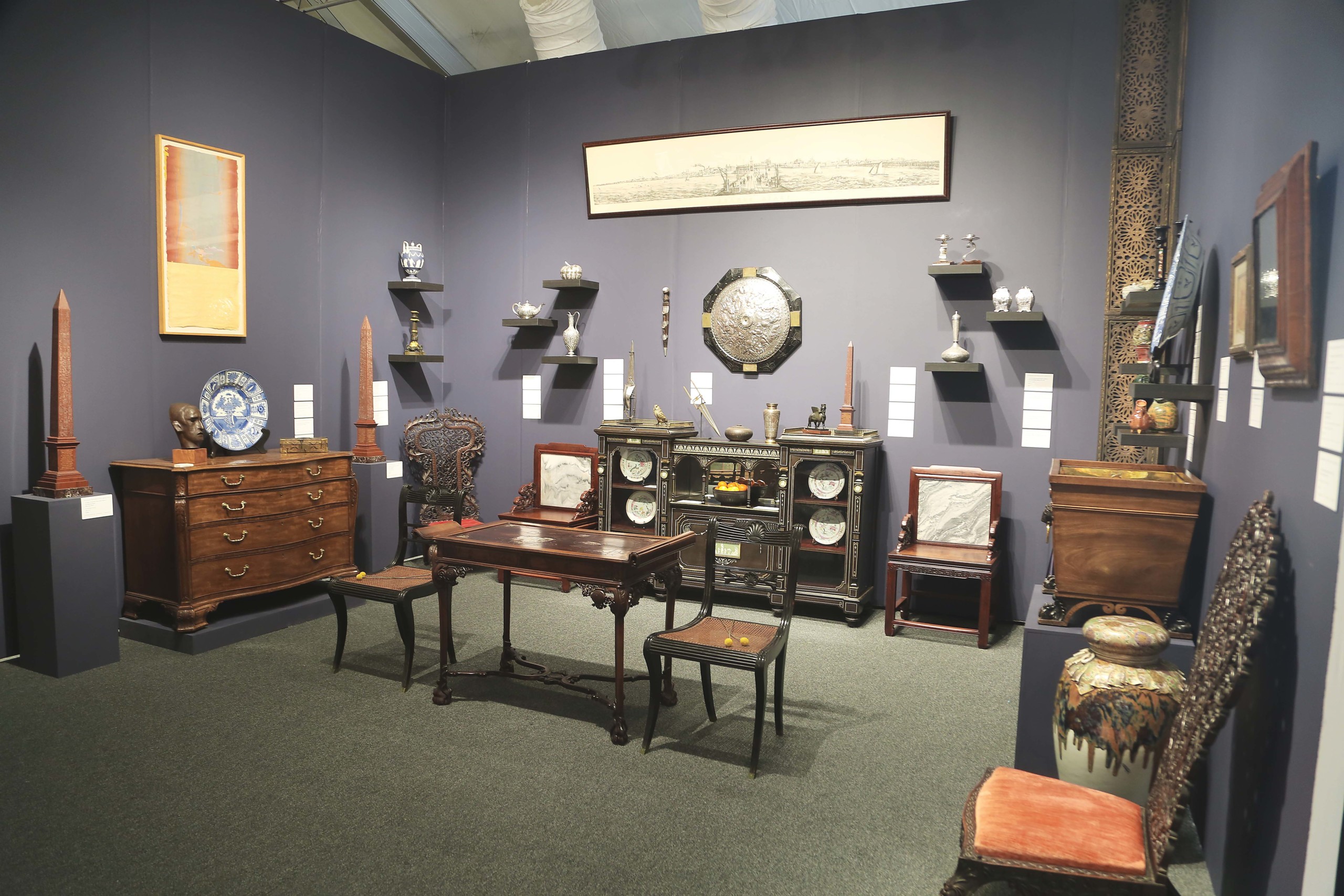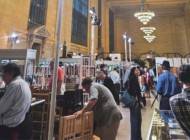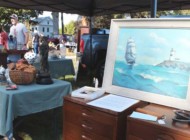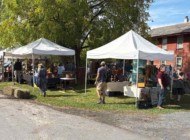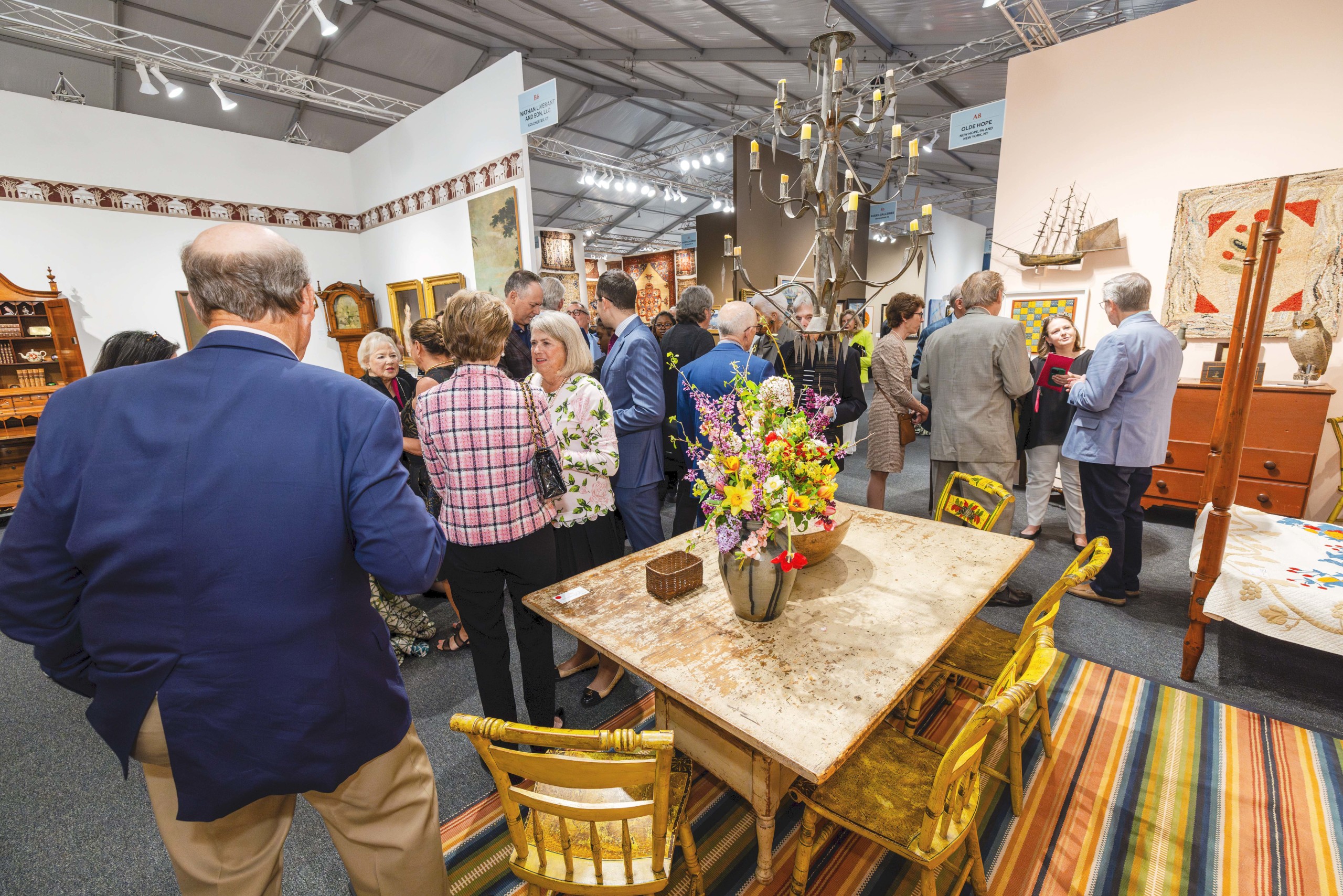
At the corner dominated by Nathan Liverant & Son, and Olde Hope, it was a crush of showgoers. Photo Courtesy of Daniel Burke Photo & Video.
Review & Onsite Photos by Madelia Hickman Ring
PHILADELPHIA — Spring takes many forms in Philadelphia: rowers and scullers take to the Schuylkill River, daffodils, tulips and cherry blossoms bloom and dance along Benjamin Franklin Parkway, and a large white tent appears on the East Terrace of the Philadelphia Museum of Art. Within that tent, 42 dealers bring everything from jewelry and miniatures to garden statuary and architectural elements, furniture, decorative arts and folk art, paintings, prints and sculpture. In short, The Philadelphia Show had arrived.
Now in its 63rd year, the show continues to benefit the Division of Learning and Engagement department at the museum; funds raised allow the museum to expand year-round family programming and provide free and low-cost museum visits for local students and educators. To achieve this goal, the annually-held dealer talks, show tours and children’s treasure hunt and art table continued but were augmented by four special events new to the show. On Friday evening, David Rago and Cecelia Bertoia, alongside director and producer Hunter Weeks, premiered Weeks’ documentary film, Harry Bertoia: Master of Metal, which featured archival footage of the artist playing his sound sculptures and several in-depth interviews. On Saturday morning, four of the show’s exhibitors who are appraisers on The Antiques Roadshow — Eric Hanks, Betty Krulik, Arlie Sulka and David Walker — gave a panel discussion with show producer, Sam Farrell. That afternoon, the Fine Objects Society (FOS) hosted a discussion moderated by Ben Miller, FOS founder and host of The Curious Objects podcast, with Independence Seaport Museum director Peter S. Seibert, architect Steven Spandle and contemporary glass artist, Amber Cowan. The final programming event, which took place Sunday morning, was a talk titled, “The Mission and Capabilities of the FBI Art Crime Team” and presented by Jake Archer, a member of the FBI Art Crime Team and Philadelphia Division team leader of the FBI’s Evidence Response Team.
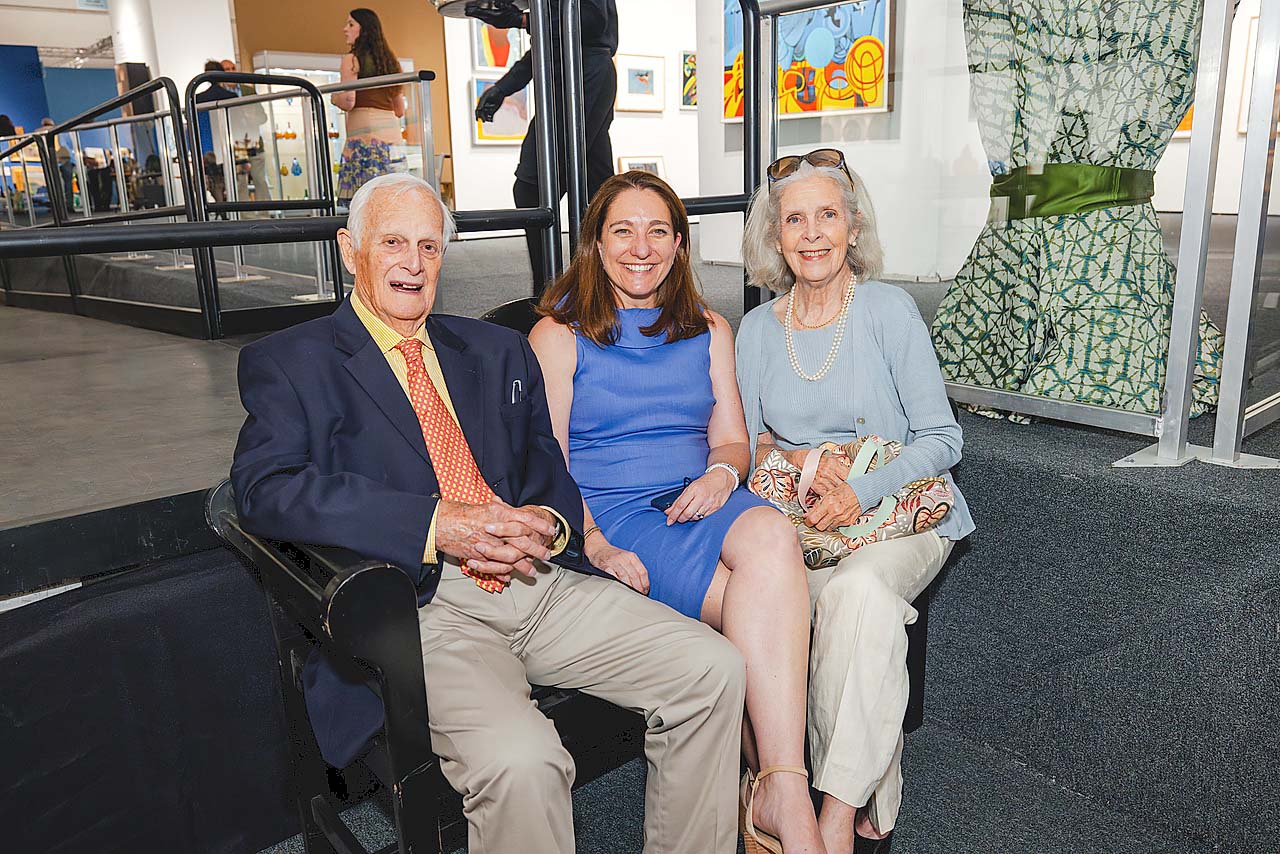
Show manager, Huntly Platt, center with Walter and Marsha Bloxsom. Photo Courtesy of Daniel Burke Photo & Video.
Show manager Huntley Platt had nothing but good things to say when Antiques and The Arts Weekly got her on the phone a few days after the show closed.
“We had a really strong opening night. The main sponsors — individuals, corporate sponsors and the collectors — were there and both Saturday and Sunday were commensurate with past years. All of the new dealers really helped create this great atmosphere — the word I kept hearing was ‘fresh’ — and there’s starting to be a real story with the glass at the show, from Lillian Nassau and traditional glass to other dealers of historical and contemporary glass.”
Another new element introduced this year was the creation of a design committee — comprised of Michael Diaz Griffith, Barbara Eberlein, Jermaine Jenkins, Camille Okhio, Marguerite Rodgers, Mona Berman Ross and Matthew Thurlow — to help spread the word about the show.
“In the inaugural year of the design committee, we had a wonderful showing, on opening night and throughout the weekend. We’ll continue to expand on that.” Platt confirmed.
Eight dealers were new to the show: Bittner Antiques (Shelburne, Vt.); Future Nostalgia Trading (Philadelphia); Glass Past (New York City); Heller Gallery (New York City); Kraushaar Galleries (New York City); Rosior (Porto and Lisbon, Portugal) and Graham Shay 1857 (New York City) and Lincoln Glenn (New York City), who were sharing a booth.

Works by Norwood Viviano were front and center in debuting exhibitor, Heller Galleries’ booth: the amber-colored mirror-shaped example on the left, the blue I-beam-based sculpture on the right and the smoky-gray work lower front. New York City.
Douglas Heller, a specialist in contemporary glass for more than 50 years, occupied one of the booths flanking the show’s main entrance. He brought works by seven artists: Anja Isphording, Christina Bothwell, Amber Cowan, Kim Harty, Tobias Mohl, Norwood Viviano and Toots Zynsky. He was eager to show off three works from Viviano’s “Re-Cast Cities” series, which “consider various social and environmental factors leading to population changes in American cities.” Viviano’s practice uses Lidar (light detection and ranging) technology and kilncast glass to create in glass three-dimension models of urban centers while incorporating shapes familiar to that area. The frame for “Recasting Philadelphia” looked like a colonial mirror of the type that were made in Philadelphia in the Eighteenth Century while “Recasting Pittsburgh” had a base in the form of a steel I-beam. Rounding out the series was “Mining Industries: Lower Manhattan” on a mirrored stand.
“The Philadelphia Show was a very positive experience,” Heller told us. “Heller Gallery was in excellent company, surrounded by quality dealers and galleries. In a way, it was a return to our roots since in our earliest days our first exhibition venues were fine antique shows where we found an audience of seasoned collectors and gradually built our initial client base.
“The response to our presentation was uniformly enthusiastic, both from fair visitors and other exhibitors. Norwood’s pieces were especially well received and the subject of endless compliments. Often people would point out a particular structure in one of the sculptures, accompanied by comments such as ‘my father worked in that building’ or ‘my first real job was right here!’ When I explained that beyond being elegant and accurate portraits of cities, the sculptures were part of a study on population shifts in response to growth and decline in iconic industries, people’s interest and admiration became even greater. Regrettably, none of those three pieces found new homes while we were in Philly, but overall the feedback from other dealers echoed our selling experience. As you well know, we are in a very stressful period with economic and social uncertainly growing daily. This cast a pall over most people’s desire to spend on non-essentials.
“We came away feeling very good about our overall experience and look for to returning to The Philadelphia Show in the future.”
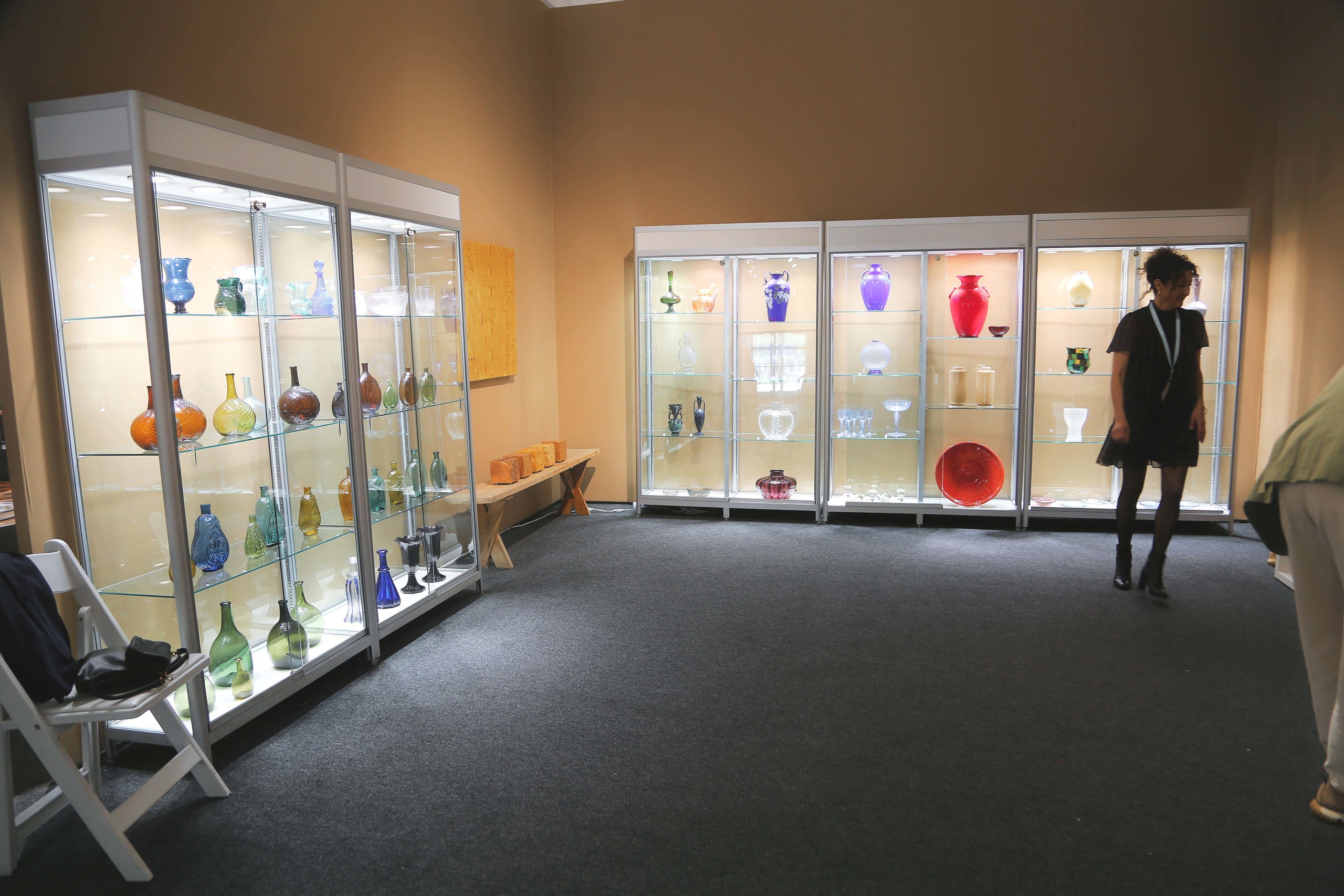
New exhibitor Glass Past, New York City.
Located across from Heller, Glass Past brought a rainbow of pieces they displayed in wall cases. The New York dealers specialize in Italian glass but they had works from other regions, spanning a range of periods between the late Nineteenth Century to late Twentieth Century.
George Perilstein, of Future Nostalgia Trading, began his career as a dealer in 2021, buying up things from people moving away from the tristate area after the pandemic. Not only was he making his debut in Philadelphia but the event was his first-ever show. Some of the stand-out furniture pieces he brought were a colorful Filosofo cabinet, made by Alessandro Guerrerio for Studio Alchimia, a desk by Le Corbusier & Balkrisna Doshi, an illuminated reading table by Pierre Jeanneret that was original designed in 1955 for the Palace of the Assembly, and a 12-drawer dresser designed in 1958 by George Nakashima for Widdicomb. Smaller objects of note included Thistle goblets by Louis Comfort Tiffany, a circa 1930s bronze and glass Tiffany & Company clock and two circa 1930s Art Deco vases made by Gaston Goor for Mougin. He gave the event a glowing review afterwards.
“I had a very positive experience. To be in that atmosphere, around so many knowledgeable customers and dealers, who had a lot to share with me, was fantastic. I had a few sales on the floor and I have follow up, which is encouraging. I ended up meeting interior designers and architects and now have ongoing dialogues with them; I was very pleased to make these new acquaintances. One of my goals in doing the show was to put myself out there and to introduce myself to new people and I think I succeeded in that.”
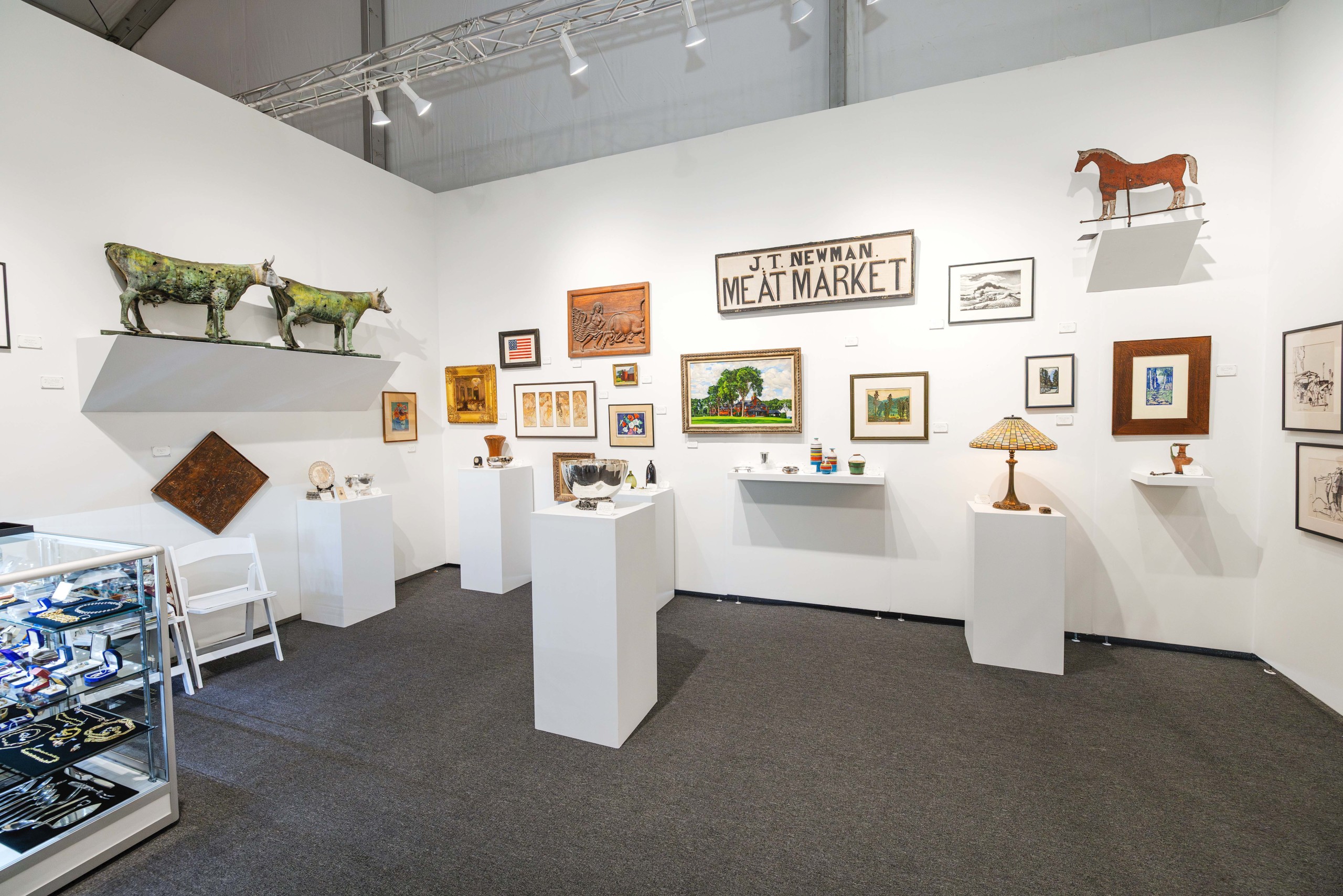
An important sale transacted by new exhibitor, Bittner Antiques, was the pair of matched cow weathervanes, shown here on the far left. Shelburne, Vt.
Bittner Antiques was across the aisle from Perilstein and was also new to the event. The Shelburne, Vt., dealer’s booth featured a great mix of items, from a set of 15 drawings by Leroy Nierman (American, 1921-2012), a painting of Shelburne House by Luigi Lucioni that was a highlight of the booth’s back wall, and a sterling silver trophy bowl, a drawing of which had been featured in the New York Journal.
Brian Bittner emailed in his post-show thoughts. “We had a wonderful experience at our first Philadelphia Show. One of the pieces we were proudest to exhibit, a pair of full-bodied cow weathervanes by Cushing & White, circa 1870s, was purchased by Gail Harrity, former president of the Philadelphia Museum, on Sunday, making for a great ending to what had already been an exciting few days. It’s rare to have a matched pair; the cows had sat for decades atop two different barns in Chappaqua, N.Y., and had clearly served as target practice, judging by their plentiful bullet holes. We’re delighted that Gail shared our view that this ‘patina’ boosted an outstanding example of American folk art to the level of something truly unique. The cows joined a diverse group of other sales, including two American flags, a Baltimore coin silver salver, three Vietri vases and several pieces of jewelry.”
“In spite of the rain and the winds, we were delighted to be a part of a diverse presentation of quality furniture, jewelry, rugs, objects and, of course, paintings. We saw some old friends and, I think, made some new ones. All in all, a lovely weekend at the top of the steps,” were the comments of Kraushaar Galleries’ Katherine Degn. Among a selection of Twentieth Century American art and contemporary artists, Hayward Oubre’s (1916-2006) painted wire figure titled “Iconoclast” was impossible to miss.
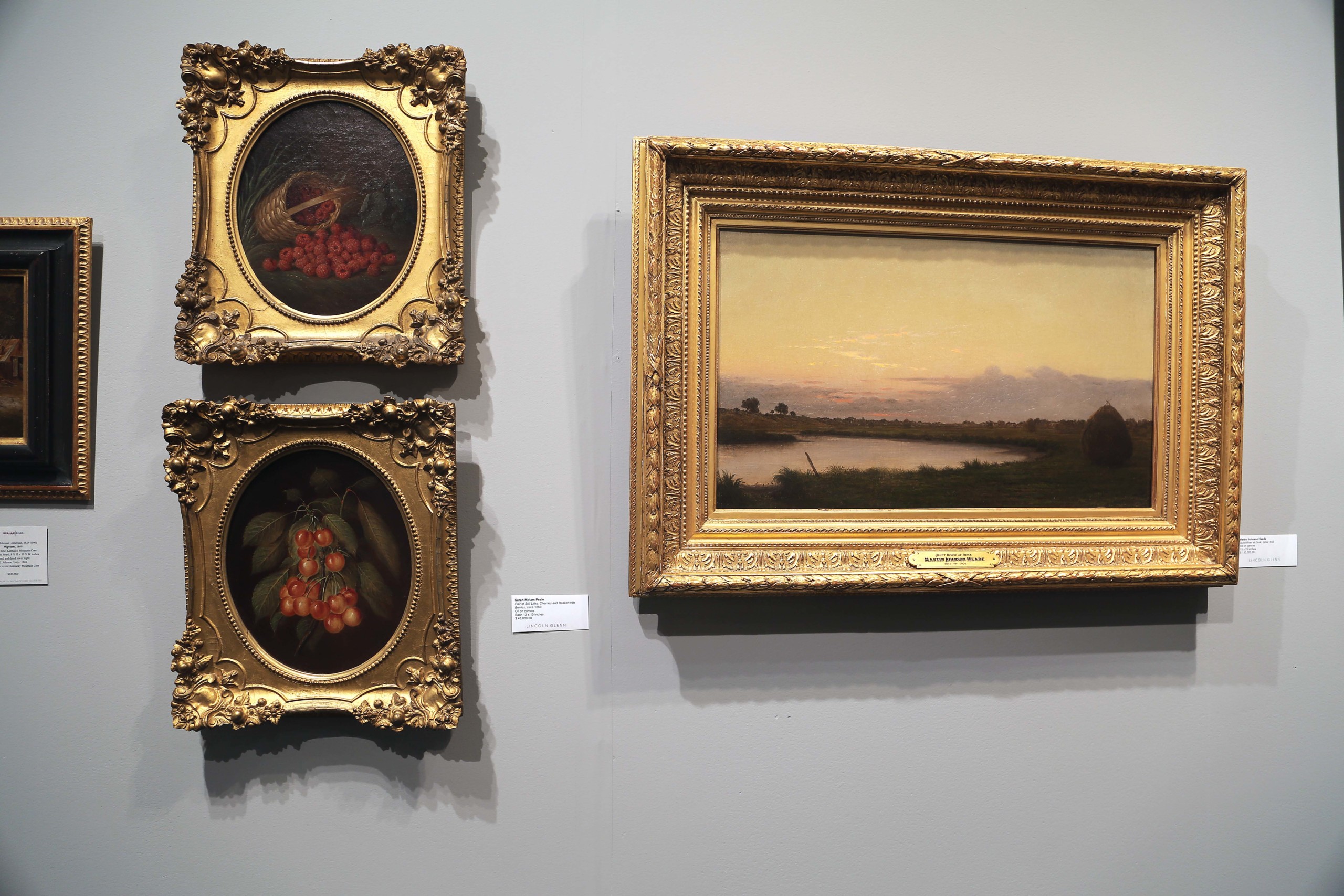
Doug Gold hung Martin Johnson Heade’s “Quite River at Dusk” alongside a pair of still life paintings by Sarah Miriam Peale. Lincoln Glenn, New York City.
New York City gallerists Cameron Shay (Graham Shay 1857 gallery) and Douglas Gold (Lincoln Glenn gallery) shared a booth, with works by American painters and sculptors they owned individually or jointly. Both were emphatic in their praise of the show, noting they each made good new contacts and loved the venue and atmosphere the show generates. Gold said watercolors by James McNeil Whistler, Jamie and Andrew Wyeth received the most attention of the inventory he brought while Shay noted his “Wigwams (Kentucky Mountain Corn)” by Eastman Johnson and “The Indian Hunter” by John Quincy Adams Ward were both “magnificent, historic and important and both got a lot of interest from seasoned collectors.”
David Walker returned to the show after making his debut in 2024. Like last year, he had a broad range of periods and styles, from a Regency mahogany wine cooler to a French Japonisme table made in the late Nineteenth Century to a circa 1850 carved side chair from Bombay to a pair of Italian rosso antico marble Grand Tour obelisks he’d acquired from Pennsylvania private collection that related to a pair from a great country house in England that sold at Sotheby’s in the 1970s.
Another exhibitor who was returning for the second time was Richard Baiano and Child’s Gallery. The Boston dealer had works by several artists: Robert Freeman, Sedgwick Guth, George Platt Lyons, Jason Berger, Erik Desmazières, Molly Luce, Joan Hall, Annemarie Petri, Andrew Guth and Walter Hancock.
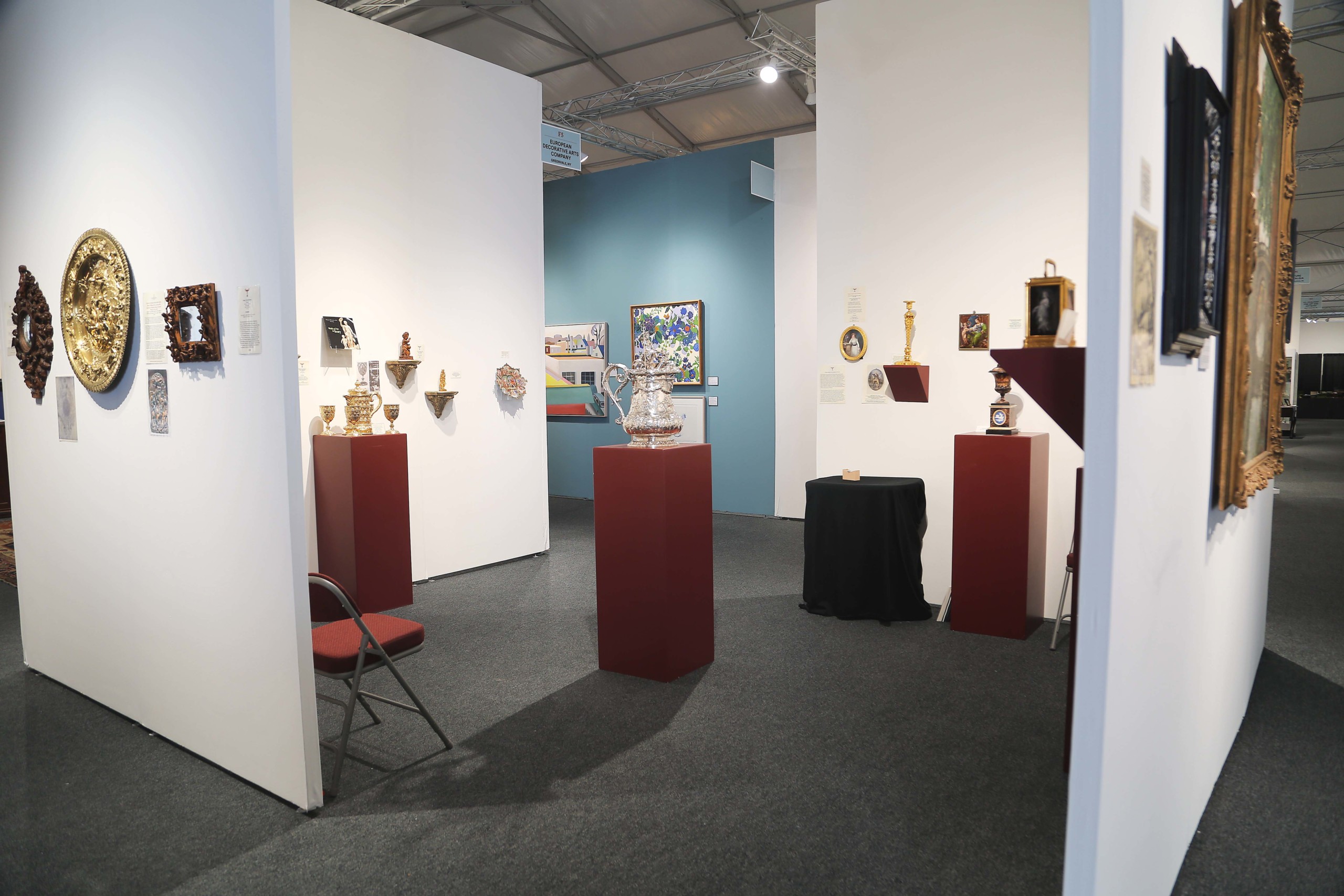
A magnificent silver tankard with provenance to the 1889 Paris Exposition anchored the booth of the European Decorative Arts Company, Port Washington, N.Y.
Scott Defrin also debuted at the show in 2024. The proprietor of European Decorative Company brought carved figures in a variety of media, as well as silver, glass, bronze and paintings. He researched each of his pieces extensively and many of the objects in his booth were accompanied by archival photographs showing those pieces in earlier collections, publications or exhibitions. Anchoring his booth was a magnificent silver tankard, made by Émile Froment-Meurice (1837-1913) for the 1889 Paris Exposition that featured an equine-themed decorative motif designed by sculptor, Isidore Bonheur (1827-1899). The piece was one of two made by Froment-Meurice and he had a great story about how he came to acquire it.
“The tankard got a lot of attention but has not yet been sold,” he told us after the show. He shared he met many new people at the show and made sales to some he knew from New York. “It’s a beautifully managed show and I am looking forward to some follow-up on a few items, particularly the great enamel paintings I had out.”
While the significant majority of exhibitors has traditionally been US-based, there is usually a small contingent of international ones to give the show a global feel; that continued in this edition. Emily Campin, director of Gladwell & Patterson, launched an elegant presentation in the UK firm’s second year. She was pleased to report back positively:
“While the broader current economic climate in the US remains somewhat uncertain at the moment, we were encouraged by the enthusiastic response to our work in Philadelphia. We were delighted to make sales to both returning collectors and new clients. The exhibition was beautifully curated and well organized, providing an elegant setting for meaningful conversations around the art. It was a pleasure to take part, and we look forward to returning next year.”
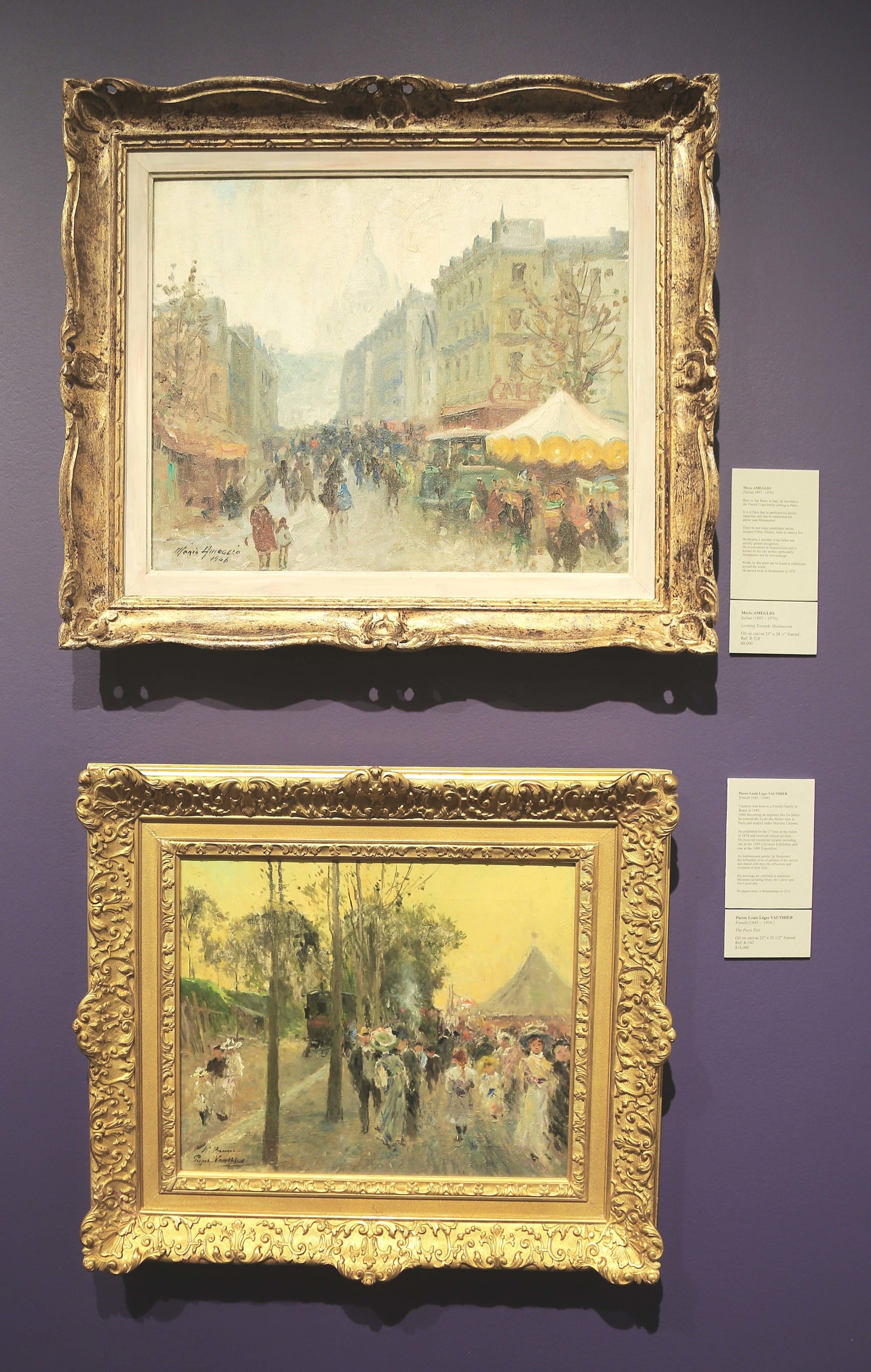
Mério Ameglio’s “Looking Towards Montmartre” (above) with Pierre Louis Lèger Vauthier’s “The Paris Fair,” both of which Thierry Doussiere had recently acquired. Antique French Fine Arts, Marseille, France & Baltimore, Md.
Several recently-acquired paintings were in the booth of Thierry Doussiere, Antique French Fine Arts, who was opposite Gladwell & Patterson and has been participating at the show since 2019. Mério Ameglio’s “Looking Toward Montmartre,” “The Paris Fair” by Pierre Louis Léger, “The Flowering Broom in Provence” by Lucien Laurent Gsell, “Barges on the Loing River” by Maurice Martin, “Le Pré Aux Loups by Rouen” by Albert Mallet, “Fishing Boats in Honfleur” by Marcel Parturier, “French Riviera” by Pierre Bittar and “The Bouchardon Mill in Crozant” by Paul Madeline were only some of the pieces he had to offer.
After the show, he reported selling several paintings, including a Marcel Cosson painting, and an Emmanuel de la Villeon, as well as a Merio Ameglio and a Cremieux. Several sold to existing collectors, but he also sold to five new clients, “always a good thing,” he said.
One of the most dynamic presentations was the booth of contemporary jeweler Rosior, from Portugal, exhibiting for the first time. The jeweler’s lavish creations were displayed with equal flourish, within cases with carved wood bases and capped with stunning floral arrangements.
“While we haven’t featured contemporary jewelry before, Rosior fit right in with their level of craftsmanship,” Platt shared.
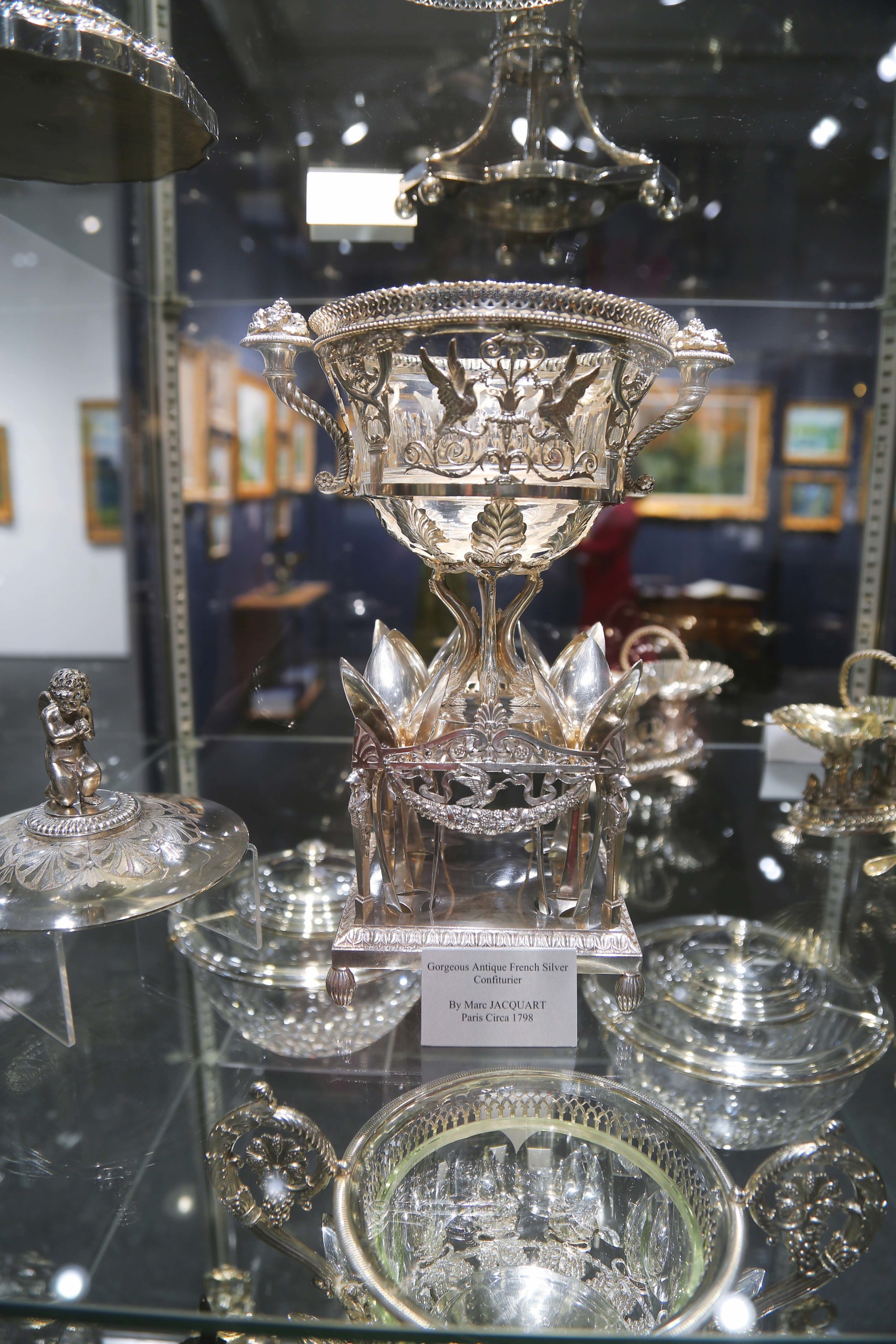
One of Jasmine Doussiere’s sales was this antique French silver confiturier by Marc Jacquart, made in Paris circa 1798. Silver Art by D&R, Marseille, France, and Baltimore, Md.
Jasmine Doussiere, who is Silver Art by D&R, reported selling “a few smaller silver items but also sold one gorgeous antique French silver pot pourri by Etienne Modoux to one of our regular clients and big collectors as well as the gorgeous antique French silver confiturier by Marc Jacquart that was actually exhibited for the first time in Philadelphia.
“The show looked really good this year, with a lot of diversity… we knew with the economy taking a down-turn, that we were facing a challenge but at the end of the day, we were happy with the outcome. It is truly a gorgeous show, and the committee, as well as the show manager Huntley Platt, do an incredible job. We feel very privileged to be part of the show,” she concluded.
In earlier days, American furniture, folk art and decorative arts were mainstays, and while the show has fewer dealers of that category than it used to, those that attended had interest and some strong sales.
The New York City firm Ginsberg & Levy began exhibiting at the show in 1972. Frank Levy continues that tradition to this day, bringing high style Eighteenth and early Nineteenth Century furniture made in some of the cabinetmaking centers in the US. Several sales were transacted on opening night: a pair of circa 1815 Classical mahogany card tables with eagle bases, attributed to Duncan Phyfe, a pair of double X-back armchairs, also attributed to Phyfe’s workshop, a near pair of flat glass mirrors from Albany, N.Y., that were related to examples illustrated in The Albany Institute of History and Art’s 1962 book, New York Furniture Before 1840 and a Chippendale camel-back sofa, made in Philadelphia circa 1760-80, that descended in the family of Philip Syng Physick. Later in the show, he sold a Delft plate featuring Adam and Eve and a pair of candlesticks, though he had interest and follow up on a few other things. Levy noted that all but two of his sales were to existing clients.
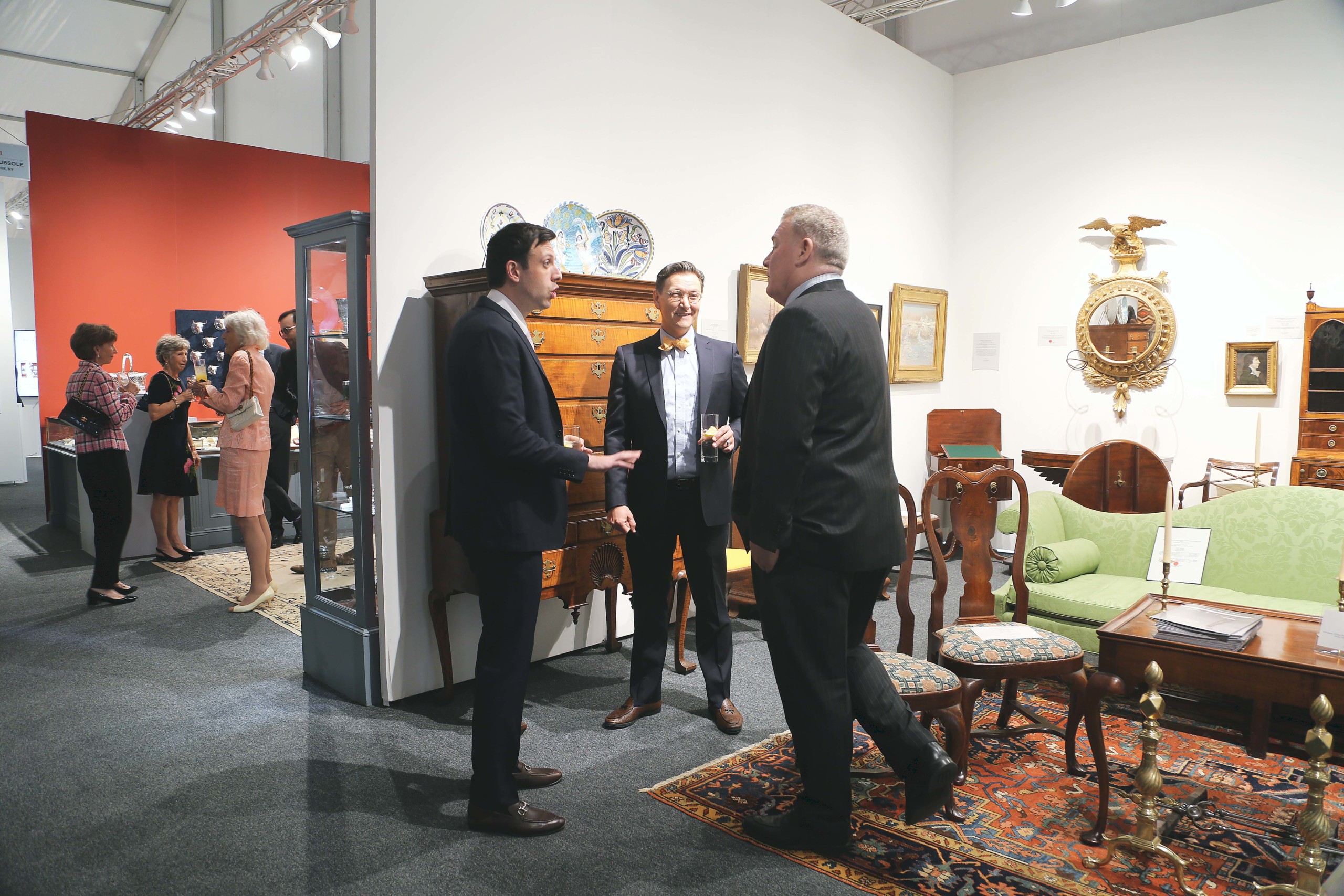
Frank Levy, right, in an engaged conversation with Kev Massoyan, left, and Steven Spandle, center. The green sofa and the eagle mirror (one of two) were among Levy’s sales. Levy Galleries, New York City.
Colchester, Conn.,-based dealer Arthur Liverant, the “son” in Nathan Liverant & Son, has been showing since 1992. Liverant’s longtime colleague, Kevin Tulimieri, was manning the booth by himself and shared his feedback as soon as he returned to the Connecticut office.
“I just love being in Philadelphia in the spring. It was a great show, a great experience. The association with the museum means everything; it’s so important to the show because it attracts knowledgeable and interested people. We love teaching — and talking about — what we sell; it was a great weekend for that.”
Tulimieri reported several sales, to a mix of both existing and new clients from all over, though the majority were local buyers. A set of five block-printed wallpaper panels by the French firm, Dufour et Cie, sold, as did a Mose Tolliver painting of a black cat with red eyes. He noted significant interest in a Chippendale secretary that anchored their back wall.
“It’s become a destination show,” Olde Hope’s Patrick Bell observed. “We have one client — a gentleman from Western Canada — who scheduled business in Philadelphia around the show, and there were a lot of good people who came. I thought it was a lovely show and well-attended. We sold half a dozen things, with interest in many other pieces.”
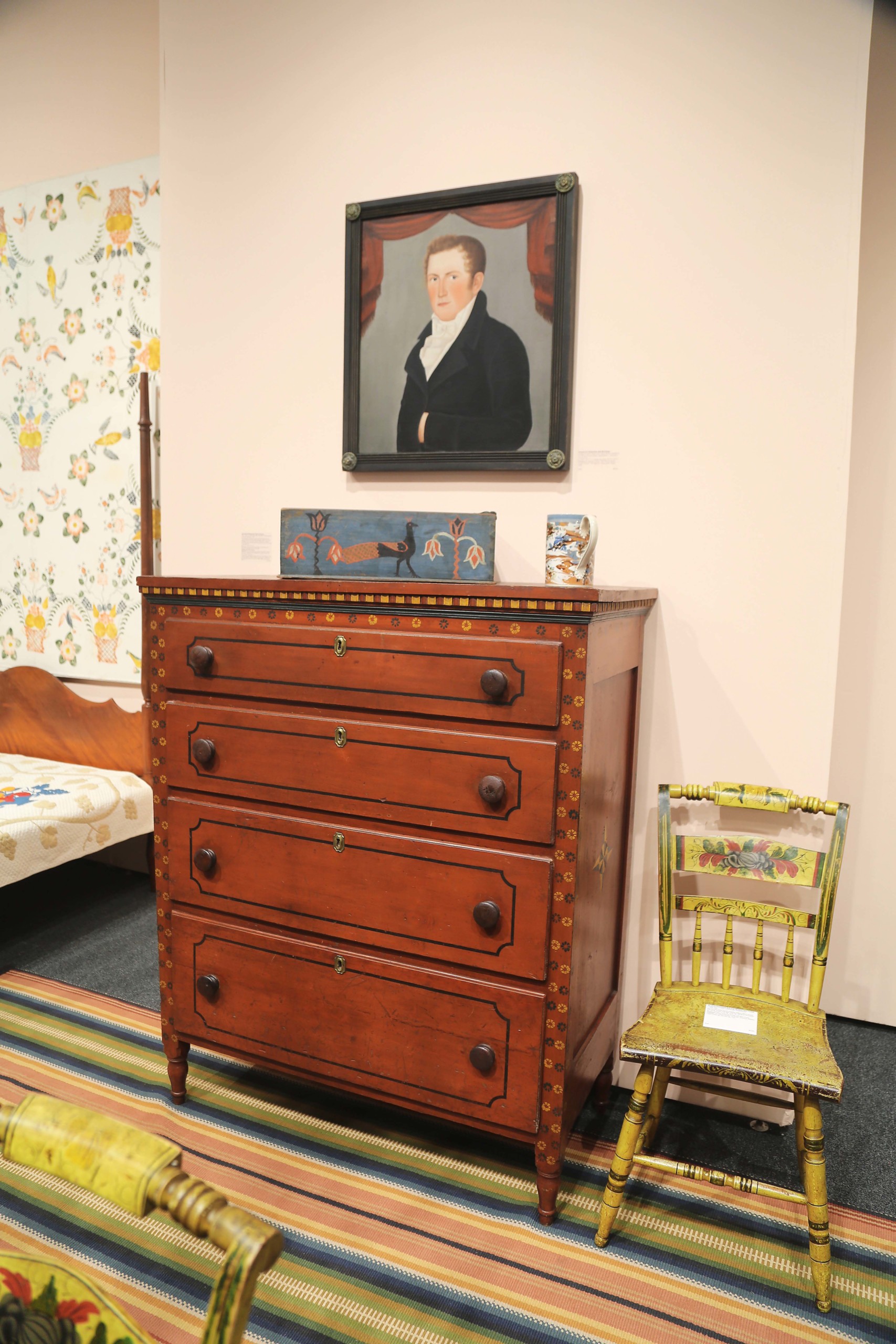
“Portrait of a Young Man” by John Tolman over a red-painted Mahantongo chest of drawers and one of a set of six yellow-painted roll-top Windsor side chairs, attributed to John D. Pratt, Lunenburg, Mass. Olde Hope, New Hope, Penn., & New York City.
The half dozen pieces Bell mentioned? A portrait of a young man by John Tolman (1777-1863), who was formerly known as the “Burpee-Conant Limner” and which anchored the back wall of Olde Hope’s booth, a watercolor of “West Ely, Mo.,” a chopping block, some baskets, a hooked rug and a mid Nineteenth Century white-painted bench table from the mid-Atlantic.
Jeff Tillou, a second-generation exhibitor at the show since 1969, had a booth well stocked with Americana, including a countertop tobacconist figure in the form of Punch by New York City carver, William Demuth, formal and painted furniture, a Prior-Hamblin school portrait of a boy holding a book, a still life of oranges and grapes by Albert Francis King (American, 1854-1945), a landscape of Lake Webster by George Fisher Daniels (American, 1821-1879) and a watercolor and ink on paper drawing by Reginald Marsh (American, 1898-1954) titled “Merry Go Round Girl,” that had provenance to the collection of the late show promoter, Sanford L. Smith.
Arader Galleries began exhibiting at the show in 1976. Experience has taught them that local views — whether in paintings, prints or maps — appeal to visitors, and Lori Cohen came prepared. Among her locally-oriented selection was an oil on canvas view of Philadelphia Harbor by Thomas Birch (American, 1779-1851), a watercolor on paper by A. Cofran titled “Philadelphia from the Great Tree under which Penn made his Treaty with the Indians,” prints of the city by John Bachmann (1814-1896), Nathaniel Currier (1813-1888) and James Merritt Ives (1824-1895), Samuel Seymour after Thomas Birch, and maps of the area by George Heap and Nicholas Scull and James Peller Malcolm.
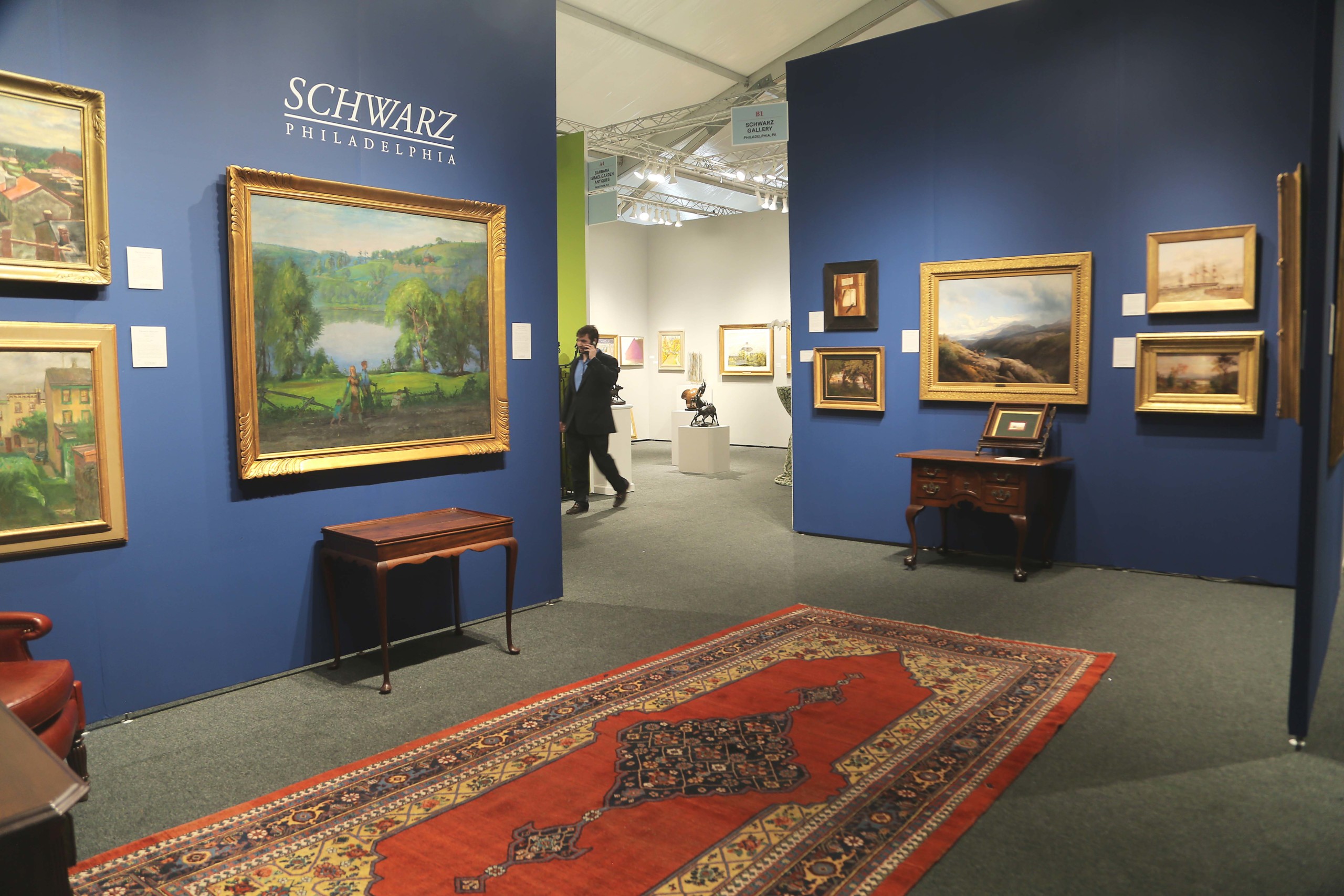
Schwarz Gallery, Philadelphia.
Fellow Philadelphia fine art dealer, Robert Schwarz transacted a number of sales on opening night: “Manayunk Steps” by Francis Speight, “In For Repairs” by Paulette Van Roekens and two works by Edythe Fisher Ferris: “On This Corner, Blind I Sing” and “Twenty Below: View of Philadelphia and the Art Museum from The Carlyle.”
The Philadelphia Show is the only fair Betty Krulik participates in, and she’s been exhibiting there since 2016. For this edition, she opted for a minimalist presentation that had maximal effect: the entire back wall of her booth was dominated by Thomas Hart Benton’s (American, 1889-1975) “Phantasy Series,” which comprised a set of four panels and two other works by the artist. “Elements of Sea and Sky” had been commissioned by Albert M. Briggs for the den of his Garden City, N.Y., home.
She reported back, telling us, “I had a lot of interest in the Bentons — they were striking, and did cause a ‘sensation’ because they are so sensational! Hard to believe they are 100 years old, they have such a modern sensibility. As they are costly, I did not expect them to sell during the show. However, I did get some good leads and have excellent follow-up.”
Chinese art was represented by Ralph M. Chait Galleries, which was not only one of the original dealers at the Philadelphia Show but which is celebrating its 115th year. The fourth-generation gallery was manned by Steven and Andrew Chait, and Joshua Chait. A large red and gold lacquered carved wood figure of a seated Guanyin, Ming dynasty and dating to circa the Fifteenth to early Sixteenth Century that relates to one in the collection of the British Museum, a rare Chinese export punchbowl for the American market that depicted the 1784 Battle of the Saintes, a pair of large Kangxi period (late Seventeenth Century) verte-glazed biscuit porcelain fu lions identical to ones at the Swinger Museum (Dresden), the Swedish royal collection and the British royal collection.
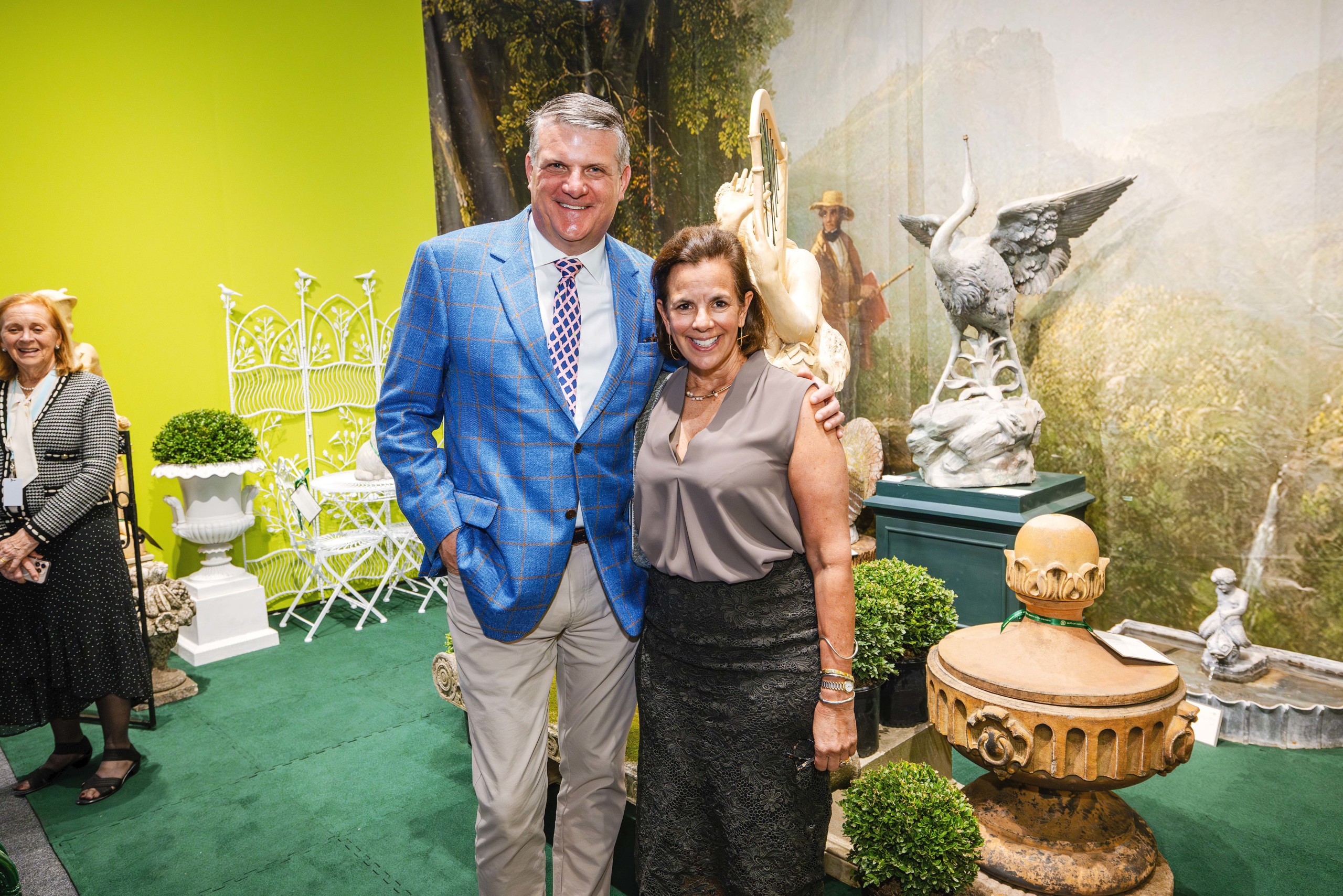
Alexandra Alevizatos Kirtley, right, is the Montgomery-Garvan curator of American decorative arts at the Philadelphia Museum of Art. She and her husband, Roger, were spotted amid the garden fountains and statuary of Barbara Israel Garden Antiques, Katonah, N.Y. Photo courtesy of Daniel Burke Photo & Video.
Next to the Chaits was garden ornament specialist Barbara Israel, who has participated at the Philadelphia Show for nearly 20 years. Israel was pleased to meet one couple who “drove all the way from Bedford, N.Y., to see our booth when, in fact, they live 10 minutes from our Katonah property where all the inventory is. So, I’m meeting them [after the show] in Katonah!”
A few exhibitors repeated to Antiques and The Arts Weekly a rumor that the 2026 show would not return to the Philadelphia Museum of Art because of potential conflicts with the city’s programming for the Semiquincentennial, the 250th anniversary of the United States. When we asked Platt to confirm if that was the case, she said “It remains to be seen; I honestly don’t know yet. We’ve looked at a couple of very good viable options if we have to move off the terrace. Because of the time it takes to plan this show, if we’re moving, we’ll need to know very soon.”
For additional information, www.thephiladelphiashow.com.
